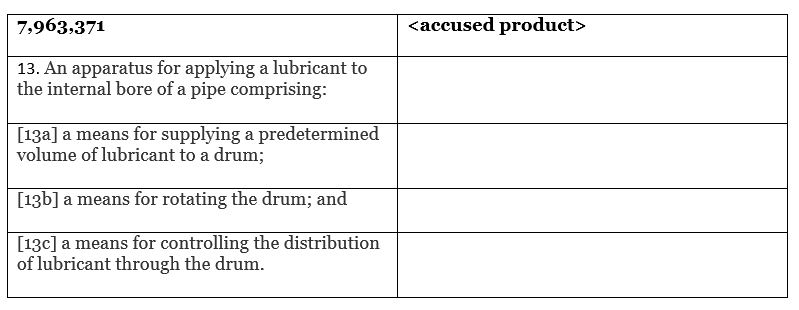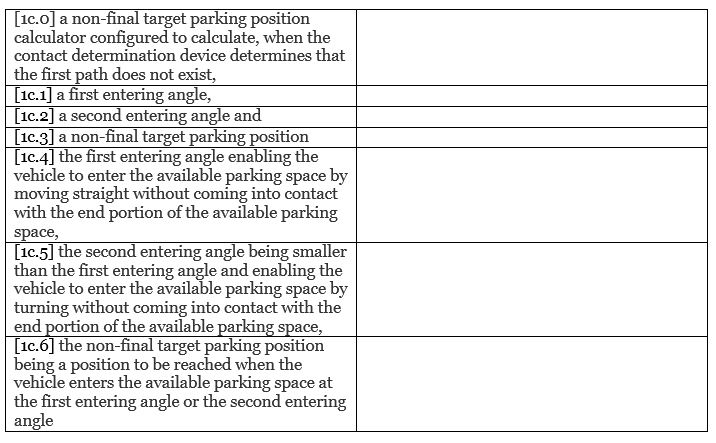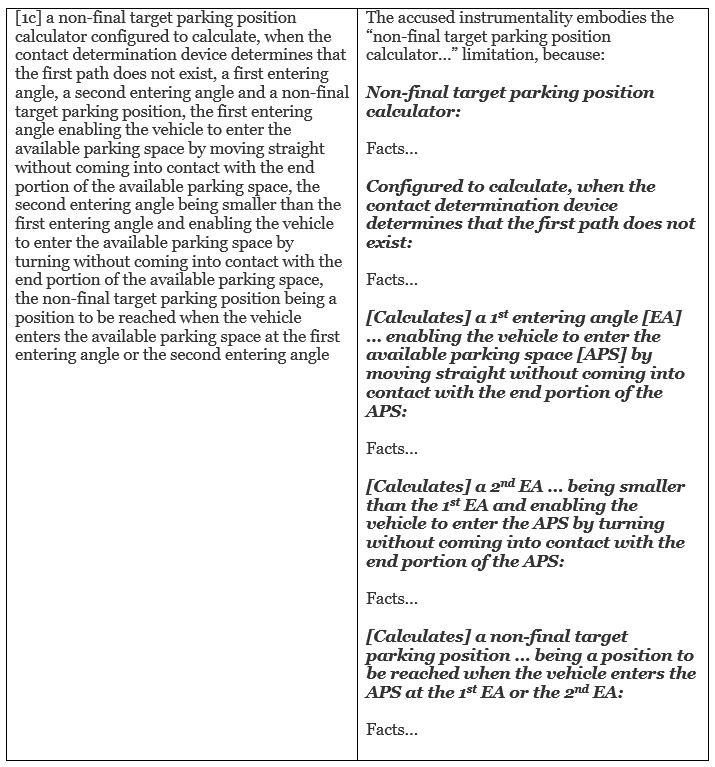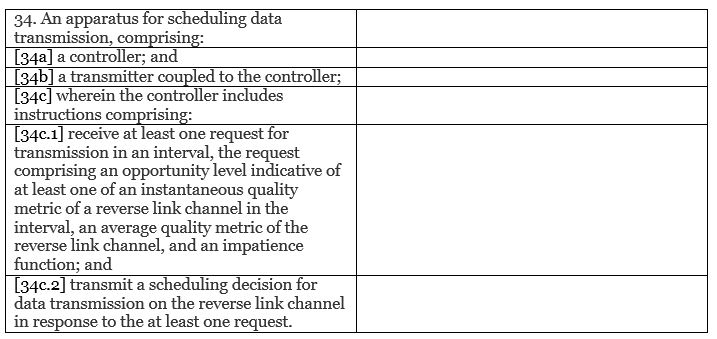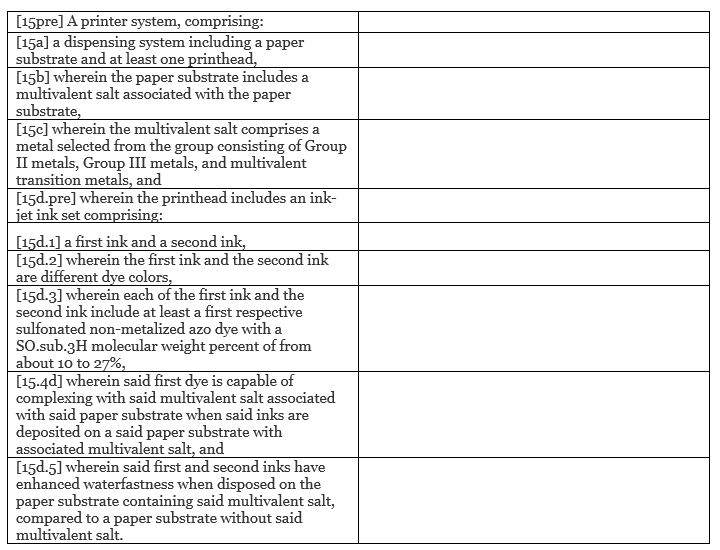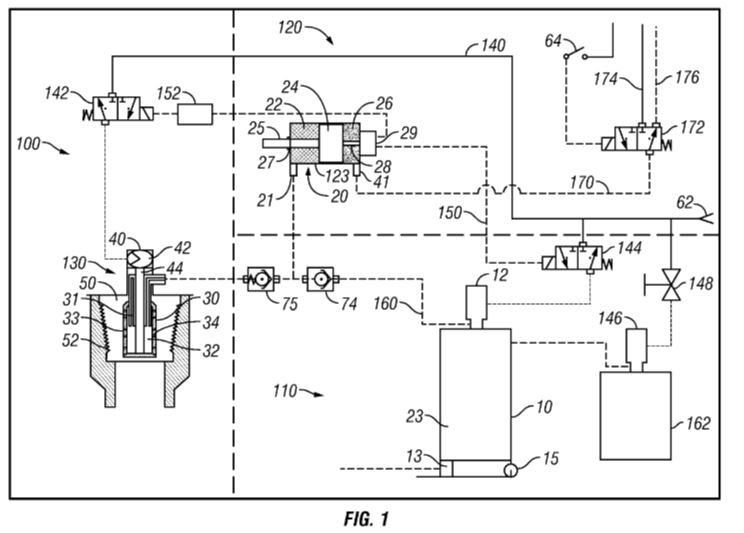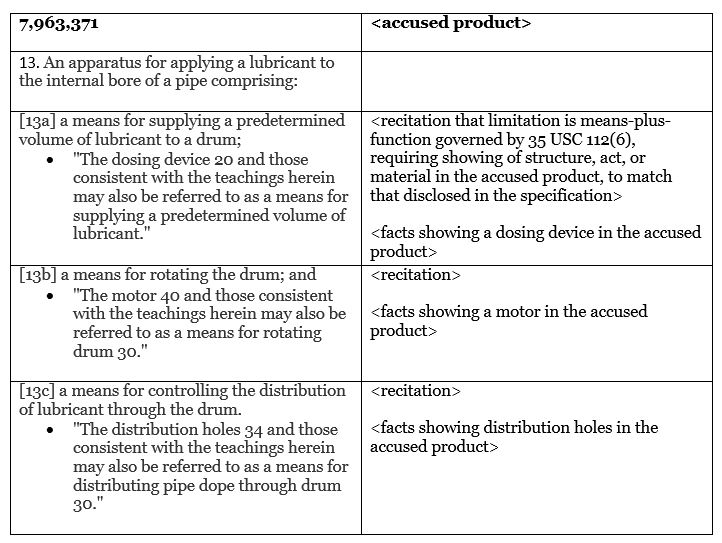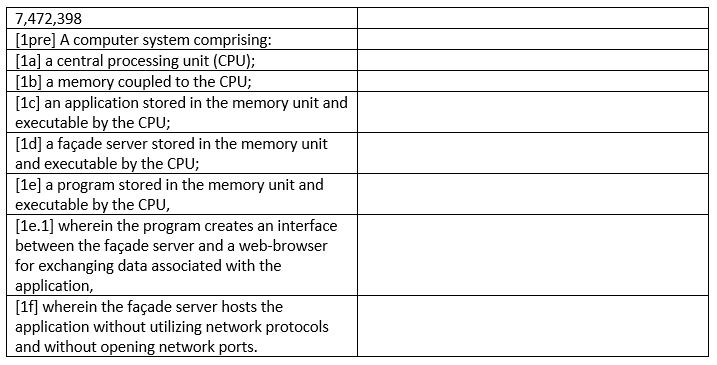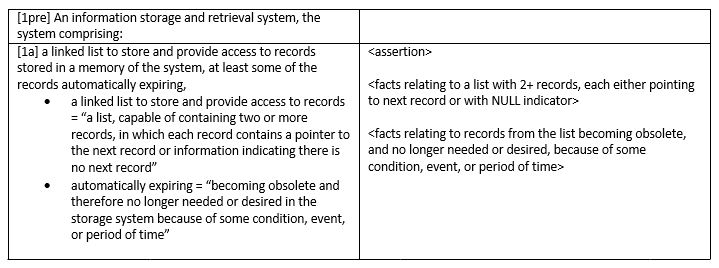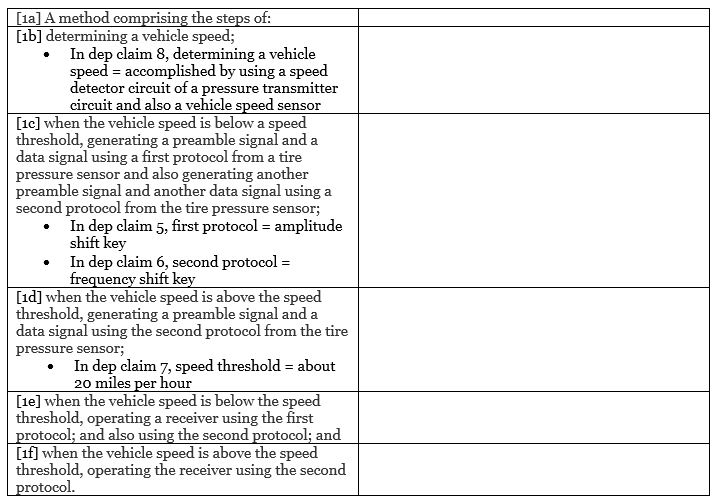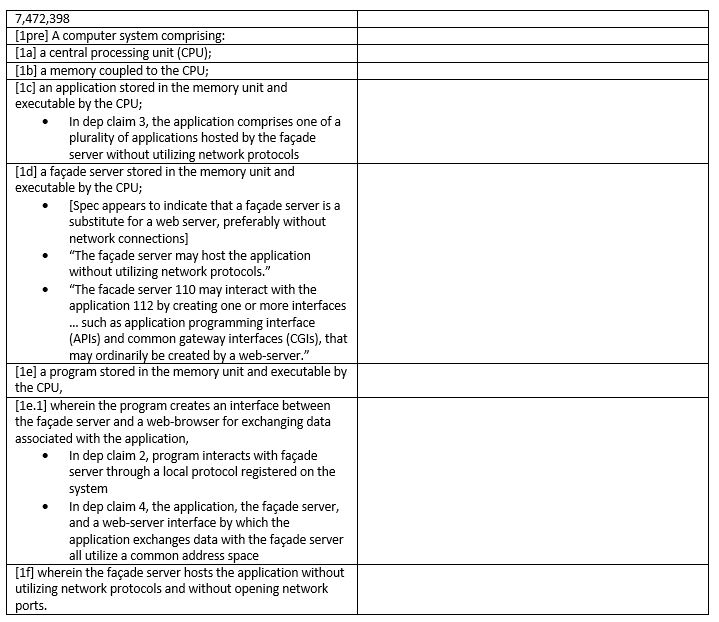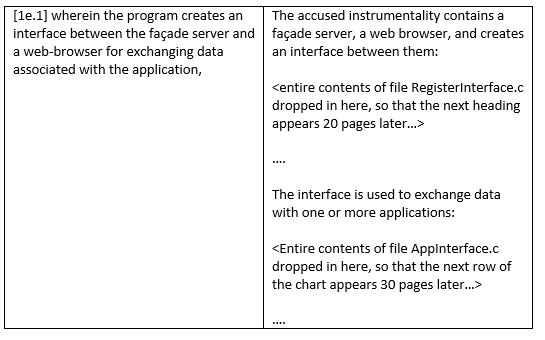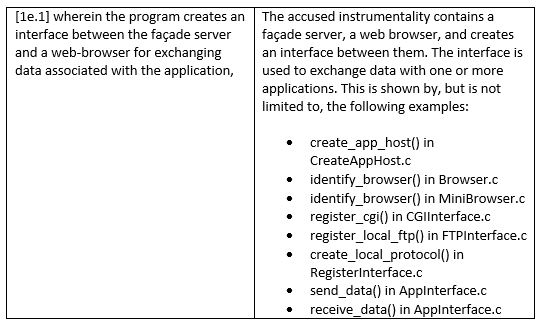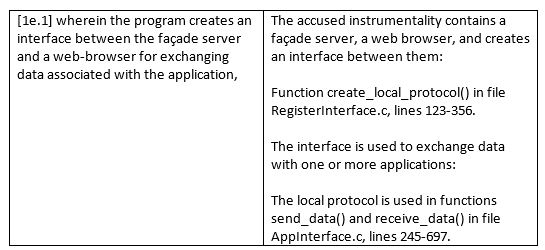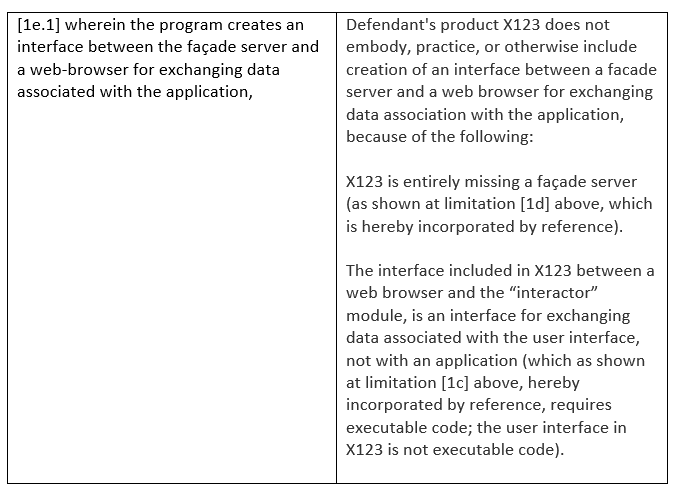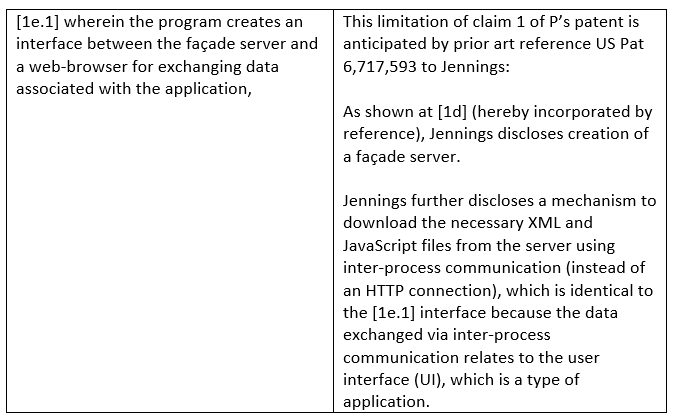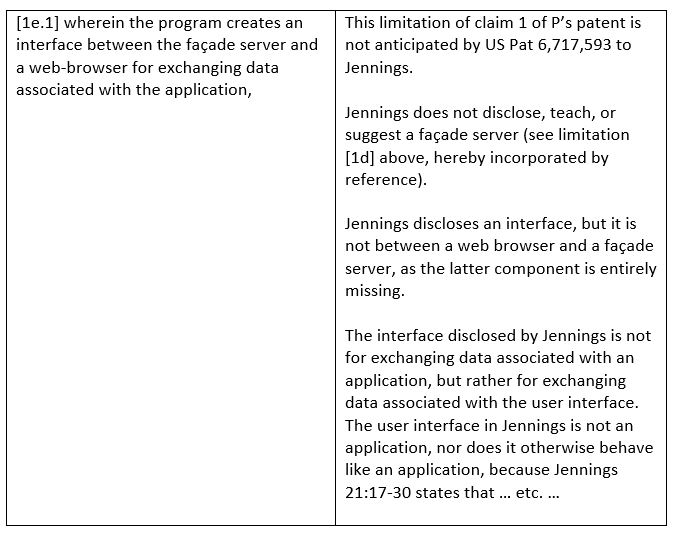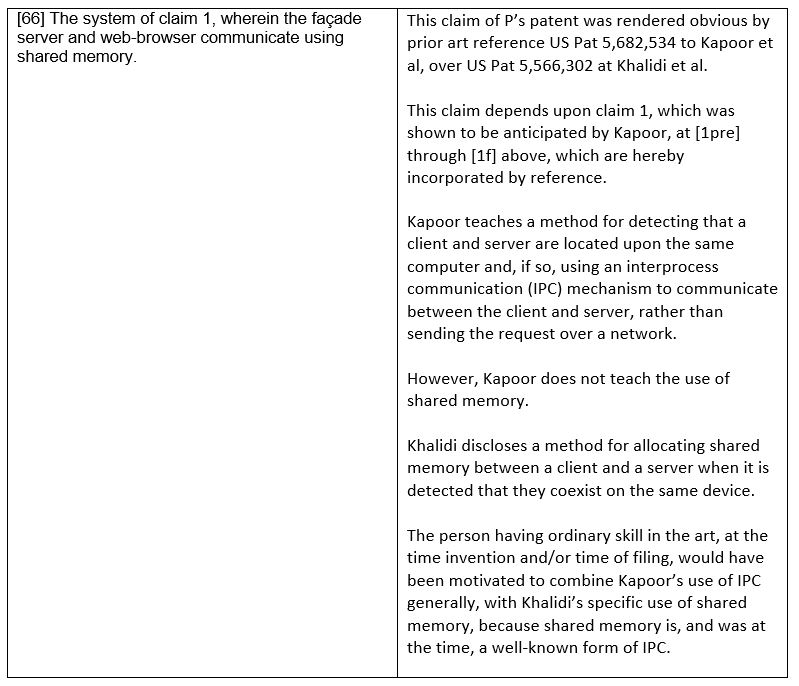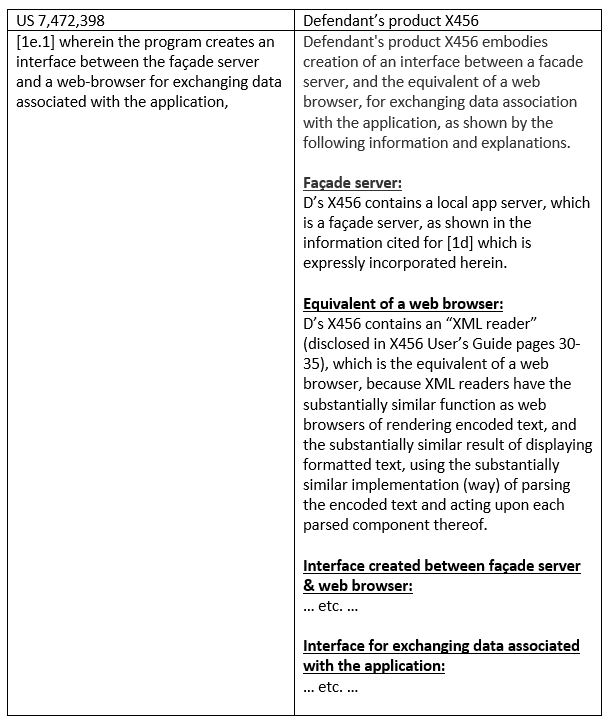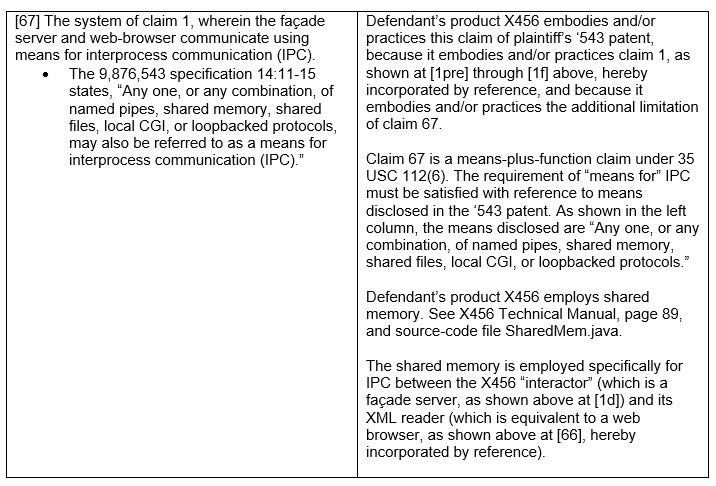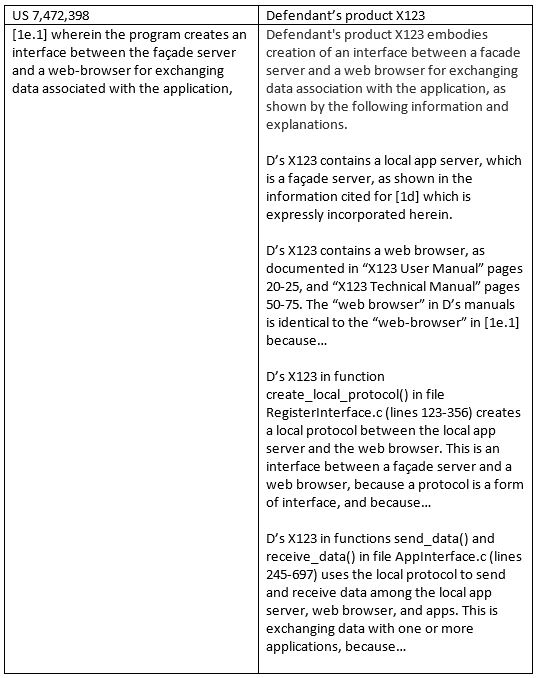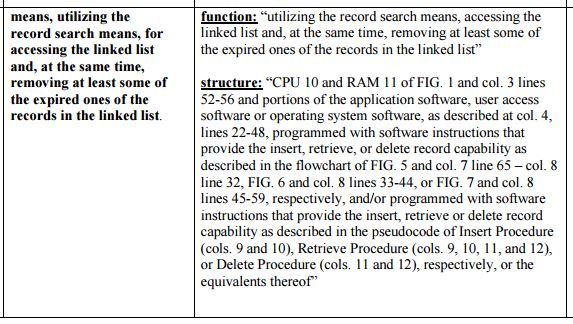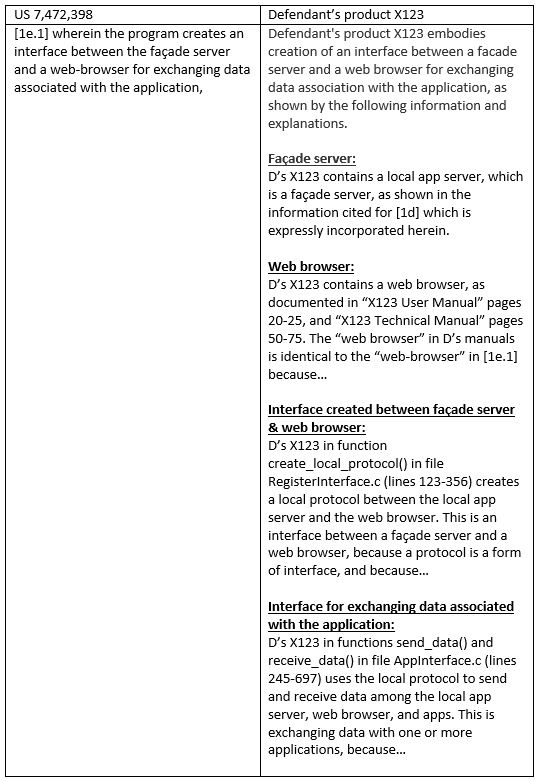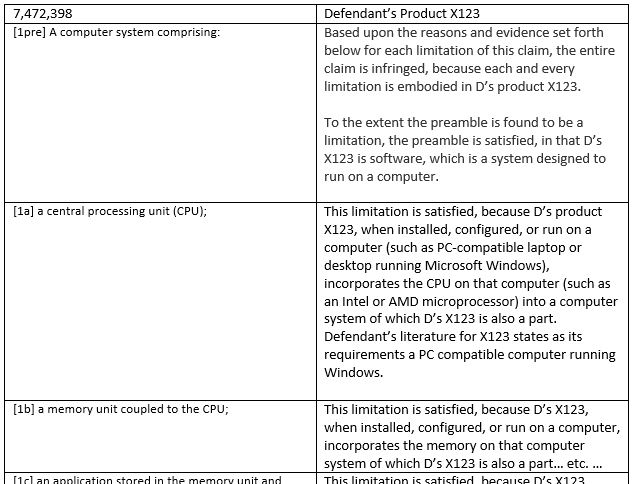PART III: DRAFTING CLAIM CHARTS
This is perhaps the most immediately hands-on section of the book, covering drafting claim charts, including overall formatting, how patent claims are split into individual rows of the chart (more than merely splitting the claim along its semicolon-designated “seams”); finding limitations and sublimitations of the claim; identifying non-limiting clauses; determining what goes into the right-hand column of the chart; handling dependent claims; and omissions (both what should or should not be omitted from the chart, and negative claims).
Not a holistic exercise
Patent infringement and invalidity are not conceptual. Showing infringement or invalidity is not a matter of seeing how the “gist” or “core” of a patent compares to something else. The title of the patent, its handy one-paragraph abstract, the sometimes voluminous text comprising the patent specification, even (except for design patents) the drawings — none of these will be used directly as the basis for comparing the patent with an accused product or with prior art. Instead, the series of single-sentence claims at the end of the patent are the basis for the comparison. True, those claims must be understood within the context of the entire patent (claim construction), and true, those claims when used in an invalidity analysis may be compared to the entirety of some prior-art patent (including e.g. drawings), but fundamentally “The Name of the Game Is the Claim.” It is each claim which is infringed or not, and each claim which is invalid or not.
But even reducing the patent to its (construed) claims does not quite capture how patent infringement and invalidity are analyzed. Almost all claims are comprised (or consist) of smaller chunks, elements of apparatus/device claims, or steps of method claims. These elements or steps are known as “limitations.” The name limitation derives from the fact that, all else being equal, the more elements or steps there are in a claim, the more limited the scope of the claim, i.e., the narrower is the territory claimed. A narrower scope in turn means it is more difficult to establish infringement, but conversely easier to defend validity.
A claim chart compares the limitations of one or more asserted claims in patent on the one hand, with what the chart asserts are corresponding elements or steps embodied in, practiced by, or (in the case of prior art) disclosed by, something else. This is, of course, not merely an idle comparison or juxtaposition, but has as its goal establishing infringement if each and every limitation of the claim or its equivalent is found in the accused product (the “All-Elements Rule”); establishing non-infringement if at least one limitation is missing; establishing lack of novelty (anticipation) if each and every limitation is found in a single piece of prior art (or shown to be inherently present); or establishing obviousness if each and every limitation is found across two or more pieces of prior art, and there would have been motivation to combine them. (See Part II on scenarios in which claim charts are used.)
Further, the comparison itself is also often divided into subparts. The clearest example is assertion of the doctrine of equivalents (DoE), for which the primary test is known as “function/way/result” (F/W/R): does the accused element have substantially the same function (i.e. purpose or role), carried out in substantially the same way (i.e. implementation), yielding substantially the same result (i.e. output)? These are three separate tests to be performed. Even an assertion of literal infringement, which concludes that two things are the same, must begin with comparison between the two things, and some basis for deciding upon their identicality, i.e., some set of attributes or features as the basis for a comparison. See “Structuring the comparison” below.
[TODO: formally introduce terminology re: elements, parts, subparts, features, attributes, sub-limitations]
Even the disaggregation of a patent into separate and standalone claims, of claims into limitations, and even of the comparison itself into separate features or attributes to compare, does not complete the extent to which claim charts differ from any sort of “holistic” comparison. A semicolon ; is typically used as the “seam” along which patent claims are split into limitations, with each limitation occupying its own row in a claim chart (see below). While a mechanical division of the claim along its semicolons often works, it also often yields one or more extremely long clauses which are simply too complicated to analyze as one chunk. Some limitations have explicit sub-limitations (often introduced with a phrase such as “wherein … further comprising”).
Even reasonably short limitations often have subparts which are best treated separately for analysis. For example, one short patent claim (7,230,856 claim 1) has a limitation “an inverter having an input and an output, the input coupled to the latch at the second node and the output coupled to a data output terminal.” While this likely should be kept together as a single row in a claim chart, any analysis of this limitation should briefly parse out the separate requirements of the input and the output; see further discussion below.
With all this disaggregated non-holistic analysis, a claim chart is not simply a loosely-coupled “parts list” or “laundry list” (see Part II on parts lists). In addition to elements or steps, a patent claim also contains interconnections or relationships among those parts or steps. Even if this interconnection is as simple as the “coupled to” in the ‘856 example just given, the claim chart must address it. Even if all limitations have been found in an accused product or prior art, they must also fit together to form a single entity (apparatus, method, system, etc.). In an obviousness analysis, there is a further explicit requirement that the claimed invention be assessed “as a whole” (see xxx).
Having seen that, in drafting a claim chart, one is definitely not taking a “bird’s-eye view,” but rather more like a “frog’s-eye view,” we turn now to the mechanics of creating claim charts.
Basics of drafting a claim chart
A claim chart is usually (though not always) a two-column table, with one row devoted to each limitation (or non-limiting clause such as a claim preamble) of each asserted claim of a patent.
The chart is often laid out in landscape (rather than portrait) mode, and if facts appearing in the right column will be especially voluminous, and/or will contain large graphics, then legal-size paper (8.5 x 14, rather than 8.5 x 11 letter size) may be chosen.
The chart can be prepared with a word processor such as Microsoft Word, or using HTML, for which the <TABLE BORDER=1>, <TR>, <TD>, </TR>, and </TABLE> tags are sufficient.
Outside the table itself, the document should contain the case designation and, importantly, any confidentiality designations. Especially if the chart will contain confidential material materials produced in discovery, the header and/or footer for each page of the chart should carry any designations required under court protective orders. Often this will include Confidential Business Information (CBI) or Attorney Eyes Only (AEO) markers. AEO is especially important when the chart contains material which should not be shown to a party’s engineers. [TODO: explain the point of AEO; also note patent-prosecution bar.]
Charts often have footers containing various caveats, to the effect that the party “reserves its right” to amend or supplement the chart, or that the chart is merely exemplary, with infringement or invalidity “including but not necessarily limited to” what is shown in a chart. Such caveats have little positive effect, and can make a negative impression. See xxx.
If multiple patents are asserted in the litigation, it is generally advisable to use a separate chart for each patent; though see xxx on the “limitations chart” which is sometimes used to represent multiple asserted patents in a complex multi-patent case.
Similarly, it is advisable to use a separate chart for each accused product, unless there is sufficient commonality among multiple accused products to justify use of “representative instrumentalities”; see xxx. Failing to heed this advice can too easily result in a mix-and-match “Frankenchart,” in which unwittingly some claim limitations come from one product, and other limitations come from another.
See xxx on three-column charts which devote a separate column to claim construction; see xxx on the situation in which certain non-asserted claims must also be charted.
[TODO: show example so far]
Assuming a standard two-column claim chart, the left-hand column (LHC) contains the asserted claims of a patent, split into limitations.
The right-hand column (RHC) contains information regarding an accused product or prior-art reference (or multiple references, in an obviousness chart). The reference to an accused “product” is not quite accurate, as it may be a product or a service, device or method, system, medium, or composition, that is accused. The term “instrumentality” is generally used. As for “prior-art reference,” this includes not only earlier issued patents, published patent application, and printed publications (which can in turn include electronic material e.g. from databases), but also earlier sale, offer for sale, or public use. [TODO: PTO/PTAB petitions are confined to patents & publications; TODO: question of how to document sale/use.]
Given a method claim in the LHC, and an assertion of infringement, the material in the RHC will show how each step of the claimed method is “practiced” or “carried out” by the accused instrumentality; the description is active. For an assertion of invalidity, the method is of course not actually carried out in most prior-art references, but is “disclosed.” [TODO: but note public use by the inventor more than one year earlier; this involves use, and not need disclose the method.]
Given a non-method claim in the LHC (device, apparatus, system, etc.), and an assertion of infringement, the material in the RHC will show how each element or part of the device is “embodied” or “incorporated” in the accused instrumentality; the description is somewhat static. [TODO: what if accuse D of “using” an apparatus?] The word “included” is perhaps too weak, suggesting that the accused instrumentality is merely a kit or disaggregated bag of parts. Even the disaggregated limitation-by-limitation analysis which is central to claim charts must, as its final product, yield a cohesive whole. [TODO: and, for obviousness analysis, with the PHOSITA motivated at the relevant time to put the parts together.]
The LHC should have a column header, repeated on each page, with the patent number. If the chart is very long, with multiple pages of material in the RHC for each limitation, it is very useful to the reader (and therefore unlikely to be done by the chart preparer) if the column header on each page includes the current claim number and limitation designation (see limitation designations such as [1a] and [1b] below). The RHC should have a column header with a brief name for the accused instrumentality or prior-art reference. Simply stating “Defendant’s products” or “Prior-art reference” is unhelpful, and less than helpful if there is more than one such product or reference in the case.
[TODO: show example so far]
Under the All-Elements Rule, infringement and invalidity of a claim are only established if each and every limitation of that claim is established (albeit possibly established via equivalence, inherency, or by combining references to show obviousness). Thus, a claim chart will as a general rule include a row for each and every limitation, even ones which appear trivial such as “a CPU” for a software-related patent or “a network” for an internet-related patent. Facts regarding the “trivial” limitation will need to be shown.
However, if a party is denying infringement or invalidity — i.e., if this is a Non-Infringement or Validity chart — the party may, if allowed by the local patent rules (see xxx on LPRs requiring admit/deny as to each limitation, and/or taking a non-deny as an admit), create a claim chart attacking only a subset of the claim limitations. This can also be useful in an expert report on non-infringement or validity. On the one hand, there is some risk in putting all one’s eggs in one or a few baskets (denying the presence of only one or a few limitations). On the other hand, it may diminish the impact of one’s best arguments to present a chart denying each and every, or nearly every, limitation.
Parsing the claim into rows of the chart
A patent claim is always a single (possibly lengthy) sentence. It is typically (though not always) divided along semicolons, and the clauses between semicolons generally represent limitations. Thus, limitations can often be extracted from a patent claim simply by dividing along semicolons (and the initial colon, setting off the claim preamble).
For example, 7,963,371 claim 13 reads, “An apparatus for applying a lubricant to the internal bore of a pipe comprising: a means for supplying a predetermined volume of lubricant to a drum; a means for rotating the drum; and a means for controlling the distribution of lubricant through the drum.” Mechanically adding a newline after each semicolon and after the colon yields:
— An apparatus for applying a lubricant to the internal bore of a pipe comprising:
— a means for supplying a predetermined volume of lubricant to a drum;
— a means for rotating the drum;
— and a means for controlling the distribution of lubricant through the drum.
Generally the final “and” is moved up to the previous line, so that there is a clean list of limitations. The results are readily placed into a table. When, as is usually the case for non-method claims, the claim does not separately identify each limitation with a designation such as “a”, “b”, and so on, it is preferable to add one for later cross-reference e.g. when charting dependent claims. Below, such a designation has not been used for the claim preamble, as this is generally not a limitation (unless it “breathes life and meaning into the claim,” per In re Wertheim), but it could have been designated as e.g. “13pre”:
In this example, the preamble refers to “applying…” which sounds like a method, but this is likely stating a mere purpose of the apparatus, which would not be viewed as a limitation. There is nothing in the body of the claim regarding the internal bore of a pipe. If the accused instrumentality happens to involve the internal bore of a pipe, the patent owner would likely want to note that in the RHC, with a statement to the effect that “While P does not believe this preamble is limiting, the accused product has been advertised for use as a lubricant to the internal bore of pipes; see <reference>.” [TODO: if P has good facts of D practicing the preamble, P might WANT the preamble to be limiting, to help avoid some prior art.]
Whether or not it is a limitation, the preamble contains the claim type (here, apparatus) which will help guide the type of infringement being asserted. See xxx on how infringers “use” method claims, but do not e.g. “import” them. [TODO: ever sell, offer, or make a method?]
All three limitations above employ “means for…”, which constitutes functional language that should be read in the context of the means disclosed in the ‘371 specification. This is one reason why this example is so short and simple. See xxx below on means-plus-function and deceptively-simple-looking limitations.
The simple mechanical splitting of a claim along semicolons into limitations, and hence into the rows of the claim chart, will often work. However, some claims do not employ semicolons. If the claim instead employs commas, and if these clearly delineate limitations, then parsing into limitations remains a simple task. For example, it is easy to parse into limitations the following: “A hair cosmetic composition used for dyeing, bleaching, or destaining hair, comprising amino-modified silicone, dimethicone, and polyethylene glycol, each with a number average molecular weight of 10,000 or more”:
— A hair cosmetic composition used for dyeing, bleaching, or destaining hair, comprising
— amino-modified silicone [with average mol. wt. of 10,000 or more],
— dimethicone [ditto], and
— polyethylene glycol [ditto].
Note that the final clause has been applied to each limitation. Here, this was dictated by the word “each” (which the author blithely added to the actual claim, 8,088,179 claim 1, to create a simple example). However, the application of such clause is sometimes questionable: do they cover each limitation, or only the one to which it is most closely juxtaposed? [TODO: probably a canon of claim construction.]
Commas cannot be used as the same sort of natural dividers as semicolons, in part because commas are often used for example in multi-party adjectives describing a single thing (e.g., “a surfactant, n-octyltriethoxysilane, diethoxyoctylsilyl trimethylsilyl ester of silicic acid”).
The word “wherein” can often be treated as the beginning of a limitation; see the discussion of sub-limitations below. If used with caution, “and” may form a useful divider between limitations (though it more typically is divider between subparts). The word “or” behaves very differently, and will be discussed below at “Limitations with choices.” Other possible divider words are “said”, “the”, “a”, and “an”, though these almost always will indicate subparts rather than entire limitations. (Searching for such words while reading a claim can help generate a “parts list” to help clarify the claim’s requirements.)
Splitting method claims into steps
For method claims, one can generally rely not only on punctuation such as semicolons or commas, but also on the presence of -ing words (gerunds) that often set forth the beginning of each step. Take for example, “A method of diagnosing the presence of a causative agent of a particular disease state in a patient suffering from diarrhoea, the method comprising the steps of: collecting a sample of an emission from the patient, wherein the emission is flatus or gas evolved from stool, analysing the emission for the absence of at least one predetermined volatile compound to obtain a result for said predetermined volatile compound that is indicative of the causative agent of a particular disease state, and diagnosing the presence of said causative agent from said result.” From this, it is trivial to arrive at the following structure for analysis of infringement or invalidity:
— A method of diagnosing the presence of a causative agent of a particular disease state in a patient suffering from diarrhoea, the method comprising the steps of:
— collecting a sample of an emission from the patient, wherein the emission is flatus or gas evolved from stool,
— analysing the emission for the absence of at least one predetermined volatile compound to obtain a result for said predetermined volatile compound that is indicative of the causative agent of a particular disease state, and
— diagnosing the presence of said causative agent from said result.
The method has three steps: collecting, analysing, and diagnosing. Note that the collecting step uses a “wherein” clause to further limit the type of emission required. Note too that the “analysing” step is somewhat compilicated in that, to infringe, the analysis must look for an absence, and must obtain a result for an absent compound, this result must be indicative of a causative agent, and the cause must be of a particular disease state. Each substep will require at least minimal separate analysis (“does the result indicate a cause?”, “is it a cause of a particular disease state?”, etc.). [TODO: make sure examples like this of “chaining” analysis are shown at RHC discussion.]
Method claims often already contain built-in step designators such as (a) and (b), which can simply be used as-is. For example: “A method of conducting an electronic online auction between a plurality of bidders, comprising: (a) receiving a plurality of bids from bidders; (b) determining, using a computer, a rank for each bid in the plurality of bids; and (c) for each bid, displaying the rank determined in (b) to the bidder who made the bid, and not displaying the value of any other bids; wherein displaying the rank comprises displaying a tie rank to the bidder if the ranking results in a tie.” It may prove useful to add in the claim number when multiple claims are asserted. This will be especially useful, for example, when charting dependent claims which elaborate on (not merely add to) the independent claim. See xxx below on dependent claims.
[TODO: need more on method claims, including a fuller example; note that order of steps is generally not important (unless sequence is implied, e.g. Tuna Processors v. Hawaii Intern. re: “the produced smoke”); steps can be combined; etc.; but this is not the place, as this section is just re: LHC with limitations, need method claim example later when discussing RHC with facts.]
Lengthy and/or complicated limitations
It can be seen in the examples already presented that, even with the straightforward parsing of claims into elements or steps, one is often left with one or more lengthy, complex limitations. For example, step (c) in the online-auction method above can be broken down into the following subparts, at least as a guide to think through whether the limitation is met by the accused product or prior-art reference:
— for each bid, displaying the rank
— [it must be the same rank that was] determined in (b) [determining a rank for each bid]
— [displaying the rank] to the bidder who made the bid, and
— not displaying the value of any other bids;
— wherein displaying the rank comprises displaying a tie rank to the bidder if the ranking results in a tie
This example may seem contrived and unnecessarily complicated, but thinking through a lengthy limitation in this way helps avoid later surprises (“hmm, we overlooked that you don’t display the value of any other bids, besides those whose rank was determined”).
The example above happens to be a method claim, but the basic point — that many limitations require some sort of further parsing or analysis — is not limited to method claims. The point was made earlier that even a seemingly-simple claim limitation for “an inverter having an input and an output, the input coupled to the latch at the second node and the output coupled to a data output terminal,” will require some separate treatment of the input and the output subparts.
This point will be taken up again below in discussing the contents of the RHC of the claim chart. However, it is initially addressed here because the question arises whether one is looking at a single complicated limitation, to go into a single row of the chart (albeit with some subheads or callouts in the RHC; see below), or whether one is really looking at multiple limitations, albeit not delimited by semicolons, each requiring their own separate row in the claim chart.
If nothing else, at some point a “limitation” is so unwieldy that it will look careless and unthoughtful to simply dump it in as a single row in a claim chart, without some acknowledgment that the limitation has subsidiary features, each of which must be present for the entire limitation to be present. That point is perhaps somewhere along a spectrum represented by the following limitations:
- “a metal substrate that has an inorganic optical contact bonding medium on a region thereof surrounding the display device and is bonded to the glass substrate by the inorganic optical contact bonding medium.”
- “switchable circuitry capable of controllably switching between a first operational state in which the terminal is electrically connected to the node and a second operational state in which the terminal is electrically decoupled from the node, the node being configured to have a signal for the functional entity communicated through it when the switchable circuitry is in the first operational state;”
- “a non-final target parking position calculator configured to calculate, when the contact determination device determines that the first path does not exist, a first entering angle, a second entering angle and a non-final target parking position, the first entering angle enabling the vehicle to enter the available parking space by moving straight without coming into contact with the end portion of the available parking space, the second entering angle being smaller than the first entering angle and enabling the vehicle to enter the available parking space by turning without coming into contact with the end portion of the available parking space, the non-final target parking position being a position to be reached when the vehicle enters the available parking space at the first entering angle or the second entering angle;”
However, even with the second and third lengthy examples above, it is not immediately obvious how one would split these into multiple limitations. The second limitation calls for something merely “capable of controllably switching…,” and does not require the switching itself; similarly, the third limitation similarly requires something “configured to calculate…” but not necessarily that the calculation occur. The detailed features of these limitations are features belonging to a single capability or configuration.
One party might prefer to set forth these features in separate rows of a claim chart, perhaps using [1c.1], [1c.2], etc. designations to indicate that they are not (or not quite) separate limitations, as in the following example using the longest of the three limitations above:
Alternatively, the individual features can be called out as subheadings in the RHC of the chart:
Note that in the subheadings the requirements of the limitation have been slightly rearranged so that, for example, “a 1st entering angle” shares a subhead with the detailed requirements for this 1st entering angle.
Given a complicated limitation such as the examples above, one feature/attribute of that limitation may be less apparent if it does not receive its own separate row in the chart, and this may at least temporarily benefit one of the parties. All else being equal, the patent owner asserting infringement will prefer fewer apparent limitations, and the accused infringer will prefer more; positions are reversed for invalidity, however. Such infringement/invalidity reversals generally help to keep the parties’ arguments within sensible and honest bounds. [TODO: somewhat different considerations if going to show a “parts list” (see xxx) at trial; P and D might prefer a long list of parts, with many or only a few check-marks.]
Sub-limitations
In some cases there is a natural division point for lengthy or complicated limitations, because they contain explicit sub-limitations. These are often set forth with a “wherein … comprises” clause. For example: “An apparatus for scheduling data transmission, comprising: a controller; and a transmitter coupled to the controller; wherein the controller includes instructions comprising: receive at least one request for transmission in an interval, the request comprising an opportunity level indicative of at least one of an instantaneous quality metric of a reverse link channel in the interval, an average quality metric of the reverse link channel, and an impatience function; and transmit a scheduling decision for data transmission on the reverse link channel in response to the at least one request.” (8,194,598 claim 34) This might be split apart into the LHC of a claim chart as follows:
Notice that in addition to the limitation designations such as [34a], there are also sub-limitation designations [34c.1] and [34c.2]. This is preferable to designating these as [34d] and [34e] because it avoids a possible fruitless dispute as to whether these are limitations or sublimitations.
This still leaves us with a lengthy sublimitation, [34c.1]. Notice that this involves a choice, “indicative of at least one of…”; charting choices is discussed below.
The example above was fairly easy to split into rows, as it contained semicolons. Below is another example, without semicolons, but containing frequent use of the word “wherein”:
“A printer system, comprising: a dispensing system including a paper substrate and at least one printhead, wherein the paper substrate includes a multivalent salt associated with the paper substrate, wherein the multivalent salt comprises a metal selected from the group consisting of Group II metals, Group III metals, and multivalent transition metals, and wherein the printhead includes an ink-jet ink set comprising: a first ink and a second ink, wherein the first ink and the second ink are different dye colors, wherein each of the first ink and the second ink include at least a first respective sulfonated non-metalized azo dye with a SO.sub.3H molecular weight percent of from about 10 to 27%, wherein said first dye is capable of complexing with said multivalent salt associated with said paper substrate when said inks are deposited on a said paper substrate with associated multivalent salt, and wherein said first and second inks have enhanced waterfastness when disposed on the paper substrate containing said multivalent salt, compared to a paper substrate without said multivalent salt.” (7,833,335 claim 15)
It takes one or two readings of this claim to realize that limitations are mostly contained within clauses beginning “wherein…”, and that one of these is a “wherein … comprising” clause indicating sub-limitations:
Note the embedded “comprising” at [15d.pre]. This denotes a sublimitation, rather than a limitation because, in this example, the “first ink and a second ink” are not simply part of the overall “printer system”, but must specifically be comprised by the “printhead.” A possibly interesting question is whether, as a preamble, albeit an embedded one, this is non-limiting.
It was noted earlier that the word “wherein” can form a natural division point between limitations, when this is not otherwise clear. Here, there are no semicolons, but “wherein” helps identify all of the limitations and sublimitations, except for those immediately following a “comprising:” clause.
Note at [15c] that the multivalent salt is a metal selected from a group. As with the previous example also involving selection from a group, not every member of the group need be present in an accused product or prior-art reference. [TODO: but that might change, depending on wording e.g. in a method claim, which might require that the selection be made as a step in the method.] This will be addressed below at “Limitations with choices.”
[TODO: anything on implicit sublimitations, from claim-construction cases?]
Deceptively-simple-looking limitations
Having just discussed lengthy and/or complex limitations, conversely the claim chart drafter often faces short, deceptively simple-looking limitations. For example, an entire limitation may call for nothing more than the presence of some thing, or step, whose name the inventor/owner has themselves created, in an exercise of the right of a patent application to “act as his own lexicographer” (see xxx). Such terms are generally comprised of standard-looking words which, when put together, yield a phrase which is not a term of art. For example:
- a vector prediction candidate
- a universal hash value
- a generic co-occurrence database
- Prefix Reachability Detection
- a facade server
An easy test for such a term is to place it inside quotation marks, plug the quoted term into Google, and see if the first or indeed only hit is to the patent itself (or another from the same assignee).
It is easy enough to put such a limitation in a row by itself, but finding something it reads on (or doesn’t) in an accused product or prior-art reference is far trickier. Clearly, the phrase itself won’t appear in a product manual, source code, or patent — unless by the same patentee. [TODO: but “facade server” is from 7,472,398 which is HP, and Google shows “facade.server.commands” as part of WebSphere Commerce; what is relation of WebSphere to HP?] If the words happen to appear is close proximity to each other, taking it as pointing to infringement or anticipatory would likely be naive.
Instead, claim construction will be needed to understand the term. This may include not only looking for definitions in the patent specification, but also carefully examining dependent claims to find non-limiting examples of what the term means e.g. in an independent claim(claim differentiation). For example, xxx. [TODO: show here, or xref to section where claim differentiation shown.]
As a result of construing such terms, the previously simple-looking limitation may expand into multiple subparts. This is most easily seen in charts produced following court-ordered claim constructions. In such charts, a party must apply the court’s claim construction, rather than the raw language of the limitation. For example, xxx. [TODO: show here, or xref to Part II section on charts containing separate column for claim construction, and/or otherwise applying claim construction. Find an example in which the claim construction results of expansion of a simple-looking term into multiple parts, rather than merely replacing it with an equally-simple synonym.]
Apart from the possible effect of claim construction, another example of the expansion of simple-looking claim terms into something more complex is provided by claims which include an explicit reference to something outside the claim. For example: “An isolated DNA comprising the nucleotide sequence of SEQ ID NO: 2” and “An isolated nucleic acid molecule comprising the nucleic acid sequence of SEQ ID NO: 1, 3, 5, or 7” , where the genetic sequences are shown separately at the end of the patent. Similarly, “A seed of soybean variety XB35F07, representative seed of said soybean variety XB35F07 having been deposited under ATCC Accession No: PTA-9332”. [TODO: here, the invention is too complex to describe in claim language, and instead a representative embodiment has been deposited.]
“Means for…” limitations (means-plus-function)
As a particularly important example of how a simple-looking limitation can expand (or effectively be replaced by a more complex description), recall one set of “means for…” limitations seen earlier: “An apparatus for applying a lubricant to the internal bore of a pipe comprising: a means for supplying a predetermined volume of lubricant to a drum; a means for rotating the drum; and a means for controlling the distribution of lubricant through the drum.” The claim contains three “means for…” limitations. It has been noted that such limitations are governed by 35 USC 112(f) (or 112(6) pre-AIA), such that the limitation is only satisfied by a structure, act, or material (SAM) matching the “means for…” disclosed in the patent specification. For example, finding anything that carries out the function of supplying a predetermined volume of lubricant to a drum will not help establish infringement (or anticipation). It must be the specific means for doing so disclosed in the patent.
It so happens that this randomly-selected patent (7,963,371) contains very clear guidance for two of the three “means for…” limitations, briefly describing them and linking them to numbered locations in a drawing:
- “The dosing device 20 and those consistent with the teachings herein may also be referred to as a means for supplying a predetermined volume of lubricant.”
- “The motor 40 and those consistent with the teachings herein may also be referred to as a means for rotating drum 30.”
- Means for controlling the distribution of lubricant is not as clearly disclosed, but note: “The distribution holes 34 and those consistent with the teachings herein may also be referred to as a means for distributing pipe dope through drum 30.”
While portions of the figure could perhaps be incorporated into the LHC of the claim chart, that is likely unnecessary, as the wording is clear enough:
- means for rotating the drum includes a motor
- means for supplying a predetermined… includes a dosing device
- means for controlling distribution… includes distribution holes
This results in the following revised claim chart. Note that the disclosure from the patent has been added as a bullet point to the LHC of the chart, and a preliminary indication is shown of how the RHC may be filled out:
For more on means-plus-function limitations, and functional limitations generally, see xxx. Note that “means for…” is not the sole signal of functional claiming.
Negative limitations, and “consisting” preambles
It was stated above that, under the All-Elements Rule, all limitations of a claim must be present in an accused instrumentality or prior-art reference, for the instrumentality to infringe or the reference to anticipate. However, limitations containing words such as “without,” “in the absence of,” “substantially free of,” and the like, have essentially the opposite effect, in that the subject of the limitation must be substantially missing from the instrumentality or prior-art reference. Some examples:
- “feeding the micro filaments without cutting or scattering the micro filaments;”
- “moving one of the fingers without touching a surface to a mode change position;”
- “such that a surface of the bulk layer is substantially free of pits.”
- “wherein each of the multiple first electrode wires is annularly formed with no seam.”
- “… hosts the application without utilizing network protocols and without opening network ports.”
It may appear that identifying an absence in an instrumentality requires proving a negative, and that this would be essentially impossible in any large multi-feature product (think Microsoft Windows or the iPhone). However, it is not the entire product that need match the negative limitation, but only the relevant accused mode or feature. As a large multi-feature product is not a wishing well or junk yard from which one can take a piece from here, and a piece from there (“let’s see, I can supply this limitation from the camera app, and this one from the calculator…”), similarly the negative limitation need only be shown within the confines of what matches the other, non-negative limitations. In other words, under the All-Elements Rule all limitations must be found together forming a single method or apparatus, and it is in this that any absences must also be found. [TODO: how does this work for damages when an entire product like iPhone is accused based on one relatively self-contained feature?]
Further, claim construction will likely allow a certain de minimus presence. For example, in Mallinckrodt v. Masimo, “without significant interference” was construed to mean that “… accurate enough for the purposes of which the calculation is being employed.” [TODO: find better example]
[TODO: careful with e.g. “without requiring” X; X can be present and still infringe, it simply must not be required; Celsis In Vitro v. CellzDirect]
Related to limitations requiring an absence, there is also an entire form of patent claim which calls, in a way, for an absence. The example claims shown until now have used the word “comprising” in their preamble. This is “open” claiming, in which infringement is found when all elements are found, even if additional elements are also present. There is also “closed” claiming, introduced with the word “consisting,” in which infringement is found when all the specified elements are found, and only these elements. This acts similarly to negative limitations, in that the absence of other elements or steps must proactively be shown. Two examples, one a method claim and the other an apparatus:
- “A process for making a stiffened and rigid paper, the process consisting of: (i) preparing a pulp slurry consisting of water, a cellulosic pulp, a starch, and optionally a binder; (ii) draining the liquid from the pulp slurry to form a web; (iii) adding at least one crosslinker; and (iv) drying the web to produce a paper product.” (8,496,784 claim 16)
- “A cigarette consisting of a tobacco rod including a tobacco filler material and a cigarette wrapper paper sheet wrapping an outer circumferential surface of the tobacco filler material, and carrying a sidestream smoke odor reducing agent consisting of a mandarin orange essential oil or a mandarin orange essential oil fraction having its terpene hydrocarbons substantially removed therefrom, wherein said cigarette carries the sidestream smoke odor reducing agent on the cigarette wrapper paper sheet.” (7,481,891 claim 1)
Closed claiming is rarely used (there were about 55 such claims in a sample of about 5,300 independent claims from 2,000 randomly-selected patents in the range 7,000,000 .. 9,200,000).
It is easy enough to see how to test a cigarette for the absence of anything other than the limitations specified in the ‘891 claim above. Similarly, if a method is found carrying out the four steps specified in the ‘784 claim above, presumably can one determine that this same method does not also carry carry out some fifth step. It is more difficult to test for absences in a device larger and more complicated than a cigarette, however. [TODO: how do negative limitations work with prior-art references?; e.g., what is the extent of the reference, does it include other patents “incorporated by reference”?]
Non-limiting clauses, preconditions, and preambles
Two example claims presented earlier at xxx included limitations calling for something “capable of controllably switching…”, or for something “configured to calculate…,” and the point was made that “capable of controllably switching” does not require that the switching actually occur, and that “configured to calculate” does not require that the calculation actually occur.
A further point is that, as with many words in claims that end in -able and -ed, “capable” and “configured” need not be done as part of the accused apparatus or method, nor need they have been done by the accused infringer. They definitely must be present, and are limitations in that sense — to infringe, an instrumentality must include the capability or the configuration — but they are really preconditions which merely need be present. [TODO: be careful not to imply that infringer otherwise must be aware of, and proactively practice, every other limitation.]
Some further examples, with comments:
- “receiving quantized data;” [The accused method must do the receiving, but the data could have been quantized long ago, by someone else]
- “a tank mounted on the hull;” [Someone else could have mounted the tank; it could come pre-mounted]
- “a programmed microprocessor;” [Someone else could have done the programming; the microprocessor is part of this apparatus, but the programming is not]
- “a programmable microprocessor” [The microprocessor must be capable of being programmed, but it need not have been; see case xxx]
- “a motor connected to the drum;” [Contrast: “connecting a motor to the drum”]
[TODO: more on the difference between -able and -ed words, vs. -ing words.]
As a somewhat different example of non-limiting (or barely-limiting) material in patent claims, “A sound generating apparatus comprising … wherein the sounds emitted from the electronic assembly are associated with an athletic event,” it should be clear that one need not put on the athletic event in order to infringe, nor need there even be an athletic event; there of course does need to be an electronic assembly that emits sounds, and these sounds need to be (of a type) “associated with” an athletic event.
Note that “associated with,” while a requirement, is a loose one. Similarly phrases, with similarly minimally-limiting impact, are “based on”, and xxx. However, contrast e.g “coupled with”, “located with”, “disposed on”, “formed on”, “provided on”, and so on, whose requirements are more tangible.
Entire clauses beginning with the word “whereby” are generally treated as non-limiting (contrast the word “wherein,” which as shown above at xxx is often used to introduce sub-limitations). For example:
- “whereby, the method provides for rapid mating and unmating of the drill pipe.”
- “whereby an automated tuning operation is created and the building operates with improved efficiency.”
- “engaging one end of an actuator shaft with the valve handle whereby rotation of the actuator shaft rotates the valve handle;”
Such “whereby” clauses are likely non-limiting for the same reason that claim preambles typically are: patent law focuses on structure rather than purpose. While it is helpful to have a given purpose or desired outcome spelled out, this does not generally impact infringement or (to a lesser extent) invalidity, where are based on what something is, or what it does, rather than why. If a given substance can function either as a dessert topping or a floor wax, it will likely infringe a patent claim to that substance, regardless of whether the claim’s preamble is for “A floor-wax composition, comprising:” or “A dessert-topping composition, comprising:”.
Limitations with choices
It was noted above at xxx that the word “and” is often a good place to divide claims into limitations, sub-limitations, and/or subparts. A further point is everything must be present in a list which includes “and”. It is sometimes difficult to determine the boundaries of that list, but at any rate the list includes everything specified in it. In contrast, the word “or” not surprisingly can have a different effect, including in patent claims. For example:
- A cosmetic composition comprising a polar solvent plant extract of Limnophilia conferta wherein the cosmetic composition is in the form of a serum, a lotion, an emulsion, a cream, a hydrogel, a mask, a stick, a patch, a hygiene product for the scalp, a make-up product, or a nail varnish. (8,241,676 claim 1)
- A system, comprising: at least one circuit for extracting an energy or power contained in a signal containing information including one or more queries for information from the at least one mote device, one or more commands for the at least one mote device to process, one or more instructions for the at least one mote device to process, or a combination thereof, the signal received by an at least one mote device, the energy or power to be utilized to at least partially operate the at least one mote device. (7,906,765 claim 38)
The first example is clear enough: either a scalp hygiene product or a nail varnish might infringe, for example. An infringing product need not be a “Swiss Army” cosmetic product.
In the second example, the “or a combination thereof” causes everything preceding it in the list to constitute an OR choice rather than an AND aggregation. An infringing system would have signals including queries, OR commands, OR instructions, OR a combination thereof. This would matter in a patent infringement case as it would, for example, ease possible disputes as to whether a query is also a command, or also an instruction.
Such a choice does not necessarily employ the word “or”; often it employs the word “and” with a preface that indicates choice. Two examples were seen earlier:
- “request comprising an opportunity level indicative of at least one of an instantaneous quality metric of a reverse link channel in the interval, an average quality metric of the reverse link channel, and an impatience function”
- “multivalent salt comprises a metal selected from the group consisting of Group II metals, Group III metals, and multivalent transition metals”
It is crucial to not confuse examples like those above with an example like the following, in which the choice among alternatives is not merely descriptive of the claimed invention, but rather is a choice made by the device or method itself:
- A device having a controller for controlling the operation of the device characterized in that the controller either adjusts the operation of the pump, or issues a warning to a user of the pump of an undesirable operating condition, or both, based on a comparison of an actual torque value and a corrected torque value; and compensating the corrected torque value based on a mechanical power offset correction. (7,080,508 claim 57)
The difference is between claims such as ‘676 and ‘765 earlier in which not every member of the group need be present in the accused instrumentality or prior-art reference, so long as at least one member is present, on the one hand, and claims like ‘508 immediately above in which the entire group must be present in the instrumentality or reference, with the selection among them a part of practicing the invention.
[TODO: need to show the whole point of this, which is how to chart such possible choices/selections]
Filling out the left hand column (LHC) of the claim chart
The left hand column (LHC) of a claim chart essentially acts as a “template” for finding material, from an accused product or prior-art reference, that will go into the right hand column (RHC) of the same row of the chart. The word “template” is used with some caution here, however, as it is important in obviousness analysis to avoid the “impermissible hindsight” that comes with treating the patent claim at issue as a template for rooting around among multiple pieces of prior art (see xxx). With that caveat, the LHC of a claim chart is a template for the RHC.
Most of what needs to be said regarding the LHC was already discussed above, in the context of splitting patent claims into limitations, with the text of each limitation going into the LHC of each row of the chart. As a further example, take 7,472,398 claim 1:
“A computer system comprising: a central processing unit (CPU); a memory unit coupled to the CPU; an application stored in the memory unit and executable by the CPU; a facade server stored in the memory unit and executable by the CPU; and a program stored in the memory unit and executable by the CPU, wherein the program creates an interface between the facade server and a web-browser for exchanging data associated with the application, wherein the facade server hosts the application without utilizing network protocols and without opening network ports.”
If split along semicolons into limitations, each limitations given a [1pre], [1a], etc. designation ([1pre] designating the non-limiting preamble), each limitation put into a separate row, and devoting a separate row for a sub-limitation (labelled [1e.1]), the results look like the following:
Note that, from this chart, one has little or no idea what a “facade server” is. Part of the goal for the following section is to use the LHC of the chart to help flesh out potential meanings for such terms, and/or provide non-limiting examples for them. It has already been seen above that “means for…” limitations (means-plus-function) can be fleshed out using bullet points in the LHC showing the specific means disclosed in the patent, to which material for the RHC must be compared (having identified the specific means disclosed for a functional limitation, it does not help if the accused product or prior-art reference is compared with the functional language, rather than with the limiting means for carrying out that function).
[TODO: xref to Part II example of means-plus-function chart, with LHC in terms of function, instead of in terms of means]
Similarly, claim construction can be added to the LHC of a claim chart. This is especially true for the court’s claim constructions following a Markman ruling, as these must be followed in any subsequent infringement or invalidity analysis. For example, Part II included an example from Bedrock v. Softlayer of a three-column claim chart, with the middle column devoted to the court’s claim construction. This can readily be turned into a two-column table with claim construction presented as bullet points in the LHC:
As with the point made at xxx above regarding means-plus-function limitations, having presented claim construction in the LHC it is vital that the claim construction be used in the RHC. This appeared to have not been done in the Bedrock chart shown in Part II. The example above suggests how the claim construction in the LHC will be used to guide the contents and analysis in the RHC. For example, rather than referring to the raw “automatically expiring” claim term, the RHC will address records that become obsolete “because of some condition, event, or period of time.” [TODO: later in section on RHC, keep going with this same sample, including facts from Bedrock chart (e.g. rt_hash_table in /net/ipv4/route.c, Linux 2.6) and see if they correspond not just to the raw claim language, but to the construed language for “automatically expiring”; see http://lxr.free-electrons.com/source/net/ipv4/route.c?v=2.6.34; actually, need struct rtable in http://nms.csail.mit.edu/software/CM/linux-2.2.9/include/net/route.h .]
In addition to including in the LHC what are essentially dictated constraints, such as means-plus-function and the court’s claim construction, it is also helpful to include at least as temporary scaffolding (to assist in building the claim chart) additional information regarding limitations, such as specific examples given in the specification. Such examples can include embodiments (including the preferred embodiment), and names of products or standards. For example, 7,800,549 includes the following disclosure: “For example, in one embodiment, the first 308 and second 310 dielectric substrates comprise DUROID TM with a TEFLON TM substrate of about 15-20 mil thickness and a relative dielectric constant of about 2.2…”. This information can be interleaved with the “dielectric substrate” limitation — so long as it is remembered that this information is not limiting on the claim, but is merely exemplary, and is being used to assist the search for infringement or invalidation. Having such information is useful because, for example, the names TEFLON or DUROID might show up even when a term such as “dielectric substrate” is unlikely to.
It is especially useful, again as “scaffolding” to help build the claim chart, to include non-limiting examples from dependent claims, when charting the independent claims on which they depend. This technique (based on claim differentiation; see xxx in Part IV) works with dependent claims of the “wherein” type (which further limit something in another claim), but not of the “further comprising” type (which add something). For example, consider 7,224,269 claims 1 and 5-8:
- 1. 1. A method comprising the steps of:
determining a vehicle speed;
when the vehicle speed is below a speed threshold, generating a preamble signal and a data signal using a first protocol from a tire pressure sensor and also generating another preamble signal and another data signal using a second protocol from the tire pressure sensor;
when the vehicle speed is above the speed threshold, generating a preamble signal and a data signal using the second protocol from the tire pressure sensor;
when the vehicle speed is below the speed threshold, operating a receiver using the first protocol; and also using the second protocol; and
when the vehicle speed is above the speed threshold, operating the receiver using the second protocol. - 5. A method as recited in claim 1, wherein the first protocol comprises amplitude shift key.
- 6. A method as recited in claim 1, wherein the second protocol comprises frequency shift key.
- 7. A method as recited in claim 1, wherein the speed threshold is about 20 miles per hour.
- 8. A method as recited in claim 1, wherein the step of determining a vehicle speed is accomplished by using a speed detector circuit of a pressure transmitter circuit and also a vehicle speed sensor.
and note how this was turned into the following claim-chart fragment: [TODO: fix below; [1a] should be [1pre], and = isn’t quite right for “comprises”]
This technique is particularly useful when the dependent claims contain names of products, protocols, standards, parts, etc. which can then form non-limiting examples of what to seek out in the accused instrumentality or prior-art reference. For example, in 8,782,060 claim 1. “A method for managing content, comprising: receiving content, wherein the content comprises standardized metadata and non-standardized metadata; …,” the “standardized metadata” component is helpfully given examples in dependent claim 2: “The method of claim 1, wherein the standardized metadata adheres to one or more of RSS, mRSS, AddContent, Cablelabs TM ADI, or TV-Anytime standards.” [TODO: possibly also use 7,532,366 claim 1 with Windows API narrowing in dep claim 4.]
Once again, to use this method one must be absolutely clear that the examples from dependent claims are just that: examples. Dependent claims provide non-limiting examples of what the independent claim might be, but at the same time make equally clear what the independent claim is not required to be.
As a final example, taking the undecorated facade server example from the beginning of this section, and decorating it with information from both the specification and the dependent claims, the result is a good bit more understandable than the earlier version which appeared at the beginning of this section:
The bullet items here are likely scaffolding which will be used to help build the claim chart, but which will be removed when the claim chart is submitted. However, as noted earlier, bullet items similar to these, but containing means-plus-function or Markman claim constructions, should likely be left in the chart, with the RHC contents explicitly referencing the bulleted text rather than the raw language of the unconstrued claim.
Filling out the right hand column (RHC) of the claim chart
It is perhaps best to begin this long and important section with several incomplete or incorrect examples.
First, the right hand column (RHC) of the claim chart is the place where facts go. However, it is incomplete to put only facts in the RHC, without any statement of what the facts mean, or how they tie into the LHC of the chart that contains claim limitations. For example:
Conversely, don’t be merely “conclusory” in the RHC, by putting in statements without sufficient facts to back them up. It may not always be apparent that one is doing this. For example, in the following fragment the RHC appears to make a factual assertion, but merely “mimics” or “apes” the claim language in the LHC, and is therefore merely conclusory; as noted at xxx, this would be not be entitled to any consideration in summary judgment (SJ), and would be as if the litigant had left an empty space in the RHC:
Having made a statement and having facts to go with it, it is best to avoid a data dump in the RHC. Courts use the term “pinpoint,” by analogy to pinpoint legal citations. While the need for pinpoint factual references is generally made in the context of post-discovery claim charts rather than PICs, an important goal generally is to be as NARROW as possible in what you put into the RHC, rather than treating it as a dumping ground. See FRCP 10(b) in Part I above, noting e.g. a claim limitation juxtaposed with 7 pages of source code without a pinpoint citation (Sutton v. Nokia), which practice has provoked an over-reaction, seeking e.g. “ONLY those lines of source code for each limitation that are necessary to allegedly meet each such limitation”, Vasudevan v. IBM. Ideally, the RHC should contain material pertaining to the corresponding limitation in the LHC, and ONLY that limitation (see xxx). This is not always achievable [because…; see xxx], but if maintained as a goal, will result in better charts (yes, more useful to the other side, but also more useful to your side, which will come to rely on your charts) than for example:
As a final example of what NOT to do, before proceeding to what SHOULD happen in the RHC of the claim chart, don’t be merely exemplary as in the following example, where it is impossible to tell (and the creator of the claim charts has likely not thought through) whether the bulleted items must all be present to infringe (i.e., an AND boolean operation), whether any one of them would be sufficient (an OR), or most likely, some combination of AND and OR, in which case the reader has, despite appearances, been given little or no notice as to what one would need to confirm or refute to establish how the RHC corresponds to the LHC:
The third and fourth examples above may appear impressive and “technical,” but this appearance is merely superficial, and has the danger of overly impressing their own creators (“hey, we really nailed limitation [1e.1]; no need to worry any more about that”).
The points made above happen to use an infringement chart, but the same types of problems frequently also appear in invalidity charts.
Having seen some examples of what not to do, we turn a more orderly discussion of what does go into the right hand column (RHC) of a claim chart.
The RHC is the place for assertions, facts, and explanations. Each is important:
- An Assertion states the point that you wish made about the corresponding limitation: that it is (or is not) present, embodied in, disclosed by, carried out by, or practiced by, etc., the accused instrumentality or prior-art reference. It is generally written in terms of the claim language (e.g. in the examples above, “facade server”).
- Facts are the basis for the assertion. The facts use the language of the accused instrumentality or prior-art reference (e.g. in the examples above, the facts do not use the “facade server” nomenclature, as that is idiosyncratic to the patent; instead the facts employ the nomenclature of the code that has been used to show infringement).
- Explanations tie the facts to the assertion. One of the problems with the poor examples above is that they do not explain WHY the selected code corresponds to the claim limitation. The “dumping” and merely exemplary” poor examples by their format almost prevent such explanations. The mark of an explanation is use of the word “because.”
Assertions and explanations are best discussed following a discussion of facts:
Facts
Recall from xxx above on the Local Patent Rules (LPRs) that the facts in the RHC of a claim chart should point to a location where the corresponding limitation can be found (or not) in the accused instrumentality or prior-art reference. Such a location is likely specified with a name, part number, line numbers, coordinates, or other designation; this will designate a part, component, step of a method, attribute, feature, or disclosure. In a prior-art reference which is a patent or published application, the location of disclosures is easily identified with column:line numbers. (Note how much more amenable to pinpointing patent prior art is, compared with other things that might be compared with patent limitations.)
The location will often be that of a “SPAFF” (“structure, process, algorithm, feature or function”); see e.g. Sutton v. Nokia, citing Connectel v. Cisco: “The charts in ConnecTel’s PICs do not refer in their text to a single structure, process, algorithm, feature or function of any accused product.” This is fairly similar to the requirement for a “SAM” (structure, act, or material) when charting a means-plus function limitation; see e.g. N.D. Cal. LPR 3-1(c).
The facts presented can be direct (e.g., source code; blueprints; schematics; photograph of the accused item) or indirect (e.g., technical manual; deposition testimony; internal documents such as functional or requirements specifications, or emails; marketing materials; screenshots of web sites), though caution is required especially for marketing materials and screenshots of web sites. See xxx on the disfavor with which courts often look upon marketing materials used in claim charts. [TODO: does that full discussion go here?]
For initial infringement contentions (PICs), created and filed pre-discovery, the facts will generally be public information, or what can be gleaned from public sources, most particularly from reverse engineering the accused product, as part of a reasonable pre-filing investigation; see PICs in Part II.
For post-discovery ICs, generally the claim chart will contain materials learned in discovery, such as internal documents and source code. A protective order (PO) may prevent direct quoting from highly-confidential material in the claim chart, and/or may restrict access to the claim chart. For example, source code is often not to be quoted “verbatim” in claim charts: one may refer to function or structure names, filenames, and line numbers, for example, but not include any verbatim line of code containing “logic” (generally, something with an equals sign). See xxx.
Other material for the RHC of the claim chart may include:
- Standards: documentation for standards, RFCs, etc. However, don’t confuse a party’s stated adherence to, or compatibility with, a standard, with the party’s adoption of each and every element of that standard. Operation of product Y cannot necessarily be inferred from Y’s support for X, together with the documentation for X. See the section on “Standards as proxies for products”, including e.g. Linex v. Belkin, Townshend IP v. Broadcom, etc.
- Third-party materials: someone other than the other side may already have written something about the workings of the other side’s products; be careful not to try employing such material in an inducement theory; see xxx
- Results of experiments and testing [TODO: more]
- Citations to expert declarations; an expert affidavit or declaration may on occasion be used to plug a hole in a claim chart [TODO: more on expert’s ability to “create facts” (and/or “create factual disputes” re: SJ.]
- “Information and belief”: this is frequently over-used [cite xxx], but can on occasion be helpful if used sparingly; see xxx on FRCP 11(b)(3)
Ideally, each row of the claim chart will contain in its RHC evidence pertaining only to the limitation in the LHC. This is sometimes called a “super pinpoint.” As noted above in the series of poor RHC examples, this can be difficult to achieve. It is difficult in part because it assumes that each claim limitation on the one hand will have a one-to-one mapping with a given element or step in the product or reference on the other hand. The law of patent infringement requires no such one-to-one mapping: a single limitation may be satisfied by two or more elements or steps, and conversely multiple limitations may together read on a single element or step [cite].
But while difficult to achieve, a “super pinpoint” can be approached by avoiding its opposite, which is the common tendency to dump information pertaining to multiple limitations into each row of the chart. This tendency is often the result of reliance on copy and paste, together with a puzzling belief that what’s good for limitation [1b], for example, is also pertinent for limitations [1c], [1d], and [1e]. One is reminded of amateurish law-school essays in which the student should be analyzing where the defendant broke and entered into the structure, but instead is focused on what the defendant intended to do inside the structure.
Along the same lines, and as also noted above in the series of poor RHC examples, it is best to avoid merely exemplary material. Signals of merely-exemplary charting are phrases in the RHC such as “See, e.g.”, “including but not limited to” (almost as if the claim chart were an interrogatory request, rather than being a replacement for an interrogatory response), or an assertion such as “The limitations below are sometimes satisfied in multiple alternative ways, the citations for which may be given in different bullet points”.
It is understandable that litigants wish to avoid putting all their eggs in one basket. But claim charts have as their purpose cementing of case theories (see Part I on the policies underlying claim charts), and such theories often include specific facts: “these five elements of the accused product [or these five disclosures in the prior-art reference] embody the limitations of the asserted claim.” Certainly, a party will want to hedge its bets, with an alternative theory (e.g. DoE or obviousness), or with an alternative set of facts: “additionally, and alternatively, these six other elements of the accused product also embody the limitations of the asserted claim.” But this is very different from: “here is a bulleted list of a dozen elements found in the accused product, and the reader is welcome to try to put them together in various ways — you might trying ANDing them together, or ORing, or some combination — to try to guess at what our theory of infringement is.” Accused infringers are not permitted such a “here, you figure out the combinations” approach when putting forward multiple references as part of an obviousness defense (see xxx on obviousness charts in Part II), but presenting raw lists of elements is arguably trying to do the same thing for infringement and anticipation.
Assertions
The RHC of a claim chart should not only set forth facts, but should employ those facts as the basis for an assertion. The point of the assertion is that the limitation reads on the instrumentality or reference, or that the latter matches the former.
This might be worded as: “The accused instrumentality embodies and/or practices this limitation, in the following element or step, and related (e.g. dependent and/or depending) elements or steps”. More specifically, for example, “Defendant’s product X embodies this limitation, in the following element and related elements” or “Defendants’s product X practices this limitation, in the following step and related steps.” The inclusion of “related” elements and steps is useful when the boundaries are unclear, as they often are. With software example, it may be useful to state, “Defendant’s product X embodies this limitation, in the following code, and related (e.g. calling and/or called) code.” Note that “element or step” might be replaced with anything from “SPAFF” (structure, process, algorithm, feature or function).
Slightly different language covers invalidity assertions (e.g., “Prior-art reference X discloses this limitation, at the following locations…”), and non-infringement assertions (e.g., “Defendant’s product X does contain an element identified as Y, but Y does not match the limitation specified in plaintiff’s patent claim” or “Defendant’s product X does not embody, practice, or otherwise contain an element which plaintiff has identified as Y; what plaintiff has identified as Y is, in fact, an entirely-different Z”).
The following example, while not ideal (it has no explanations; see below), is closer than the four earlier examples to what is desirable in the RHC of a claim chart:
Explanations
The RHC of a claim chart should, in addition to facts and assertions, also set forth some explanation of why or how the facts support the assertion. As seen in Part I, this is required under some LPRs for DoE and obviousness, and generally under proposed federal legislation (“… For each accused instrumentality … a clear and concise statement of — (A) where each element of each claim … is found within the accused instrumentality; and (B) with detailed specificity, how each limitation of each claim … is met by the accused instrumentality”; emphasis added). Faced with conclusory claim charts, several courts have ordered a party when amending the chart to provide some explanation, this presumably being viewed as a way to compel a non-conclusory chart. [cite; Intertrust v. Microsoft?]
The word “because” generally signals an explanation:
<PRODUCT> at/in <FEATURE, LOCATION, PART, ATTRIBUTE, USING NOMENCLATURE OF PRODUCT> embodies/practices a <USE NOMENCLATURE OF LIMITATION OR SUB-PART> because <EXPLAIN WHY FEATURE = LIMITATION>
For example:
“Defendant’s accused product X123 in its LocalServer.c and AppServer.c modules embodies the claimed facade server, because a facade server is a form of web server hosting local applications, and the LocalServer.c and AppServer.c modules use web services such as HTML and local CGI in order to provide support for applications local to the computer, i.e. not on the network.”
For invalidity:
<REFERENCE> at <CITE> discloses <USE NOMENCLATURE OF REFERENCE> which thereby discloses a <USE NOMENCLATURE OF LIMITATION> because <EXPLAIN WHY REFERENCE = LIMITATION>
For example:
“Marlby ‘234 at 4:16-30 discloses a local app server, which thereby discloses a facade server, because a facade server is a form of web server hosting local applications, and Marlby ‘234 discloses the use of web services such as HTML and local CGI to provide support for applications local to the computer, i.e. not on the network.”
Note how the product/reference and the limitation are explicitly tied together in the above formulations, and how use of the word “because” practically forces the claim-chart drafter to be non-conclusory, and to “weave” together some discussion of the limitation and of the product/reference.
Of course, <NOMENCLATURE OF LIMITATION> might include claim construction, and/or means-plus-function, rather than the raw language of the claim. In a real case, “facade server” (a product of the inventor acting as its own lexicographer, and not a term of art) would almost certainly be construed. [TODO: should the “because a facade server is a …” formulations above be changed to something at least proposing a claim construction?]
Interim examples
The suggested formulations here can be adopted for non-infringement, validity, the doctrine of equivalents, means-plus-function, and obviousness. See function/way/result analysis under the doctrine of equivalents below; means plus function at xxx; and obviousness at xxx.
Non-infringement:
The formulation “does not embody, practice, or otherwise include…” has been used to avoid a “pregnant negative”. The formulation could perhaps also state “either literally or equivalently,” to proactively deny a DoE assertion that P apparently has not yet made.
Cross-references (incorporated by reference) are made to previous limitations [1d] and [1c], to avoid repetition.
The RHC states that one subpart (“facade servcer”) is entirely missing, and that another subpart (interface) doesn’t have the correct attribute (exchanges data pertaining to something other than the required “application”).
Invalidity:
The above is intended merely as an example, and is not intended to state that the facade server patent is invalid. Indeed, the material above comes from the file wrapper for application 10/715,250 (http://storage.googleapis.com/uspto-pair/applications/10715250.zip), which eventually resulted in the issuance of the facade server patent.
The accused infringer will often have multiple prior-art references it wishes to use to show anticipation. It is generally better to create a separate claim chart for each such reference, rather than group them into a single chart, unless of course if the multiple references are being combined for an obviousness showing.
Validity:
While the above example of a validity rebuttal chart uses a slightly different multi-paragraph format from the previous examples of non-infringement and validity charts, the RHC contains the same basic parts: assertion, facts, and explanation. The division into separate paragraphs here could also have been adopted for the non-infringement and validity charts.
Note use of the formulation “does not disclose, teach, or suggest”.
[TODO: confusing below to have Infringement after and Non-infringement, Validity, and Invalidity above. Re-arrange material so this series of facade-server examples all go together, and have same section also include Means-plus-function (‘398 claim 15: “means for hosting the web-based application, … wherein the means for hosting the web-based application does not utilize network protocols and does not open network ports.”), DoE (f/w/r, Obviousness (10/715,250 file wrapper: 5,682,534 + 5,566,302), and Method claim (‘398 claim 6: “6. A computer-implemented method comprising: generating application data from a web-based application hosted on an executable facade server via a web-server interface; … wherein the executable facade server hosts the web-based application without utilizing network protocols and without opening network ports.”).]
Obviousness:
[TODO: need to redo example below; should say: patent is obvious OVER first reference, in view of second reference.]
[TODO: this is a contrived example, suggested by the file wrapper. Note the use of a 2nd reference to fill a missing subparts from the 1st reference. The subparts could have more clearly been set forth with subheadings, but it seems clear enough. No need to fetishize a technique like subheads: use when useful. Note that the motivation is combine is not merely asserted, but given a brief explanation (“because shared memory is, and was at the time, a well-known form of IPC”).]
Doctrine of equivalents (DoE):
[TODO: the arguments about equivalence of XML reader and web browser are hardly perfect (does this XML reader render images?), but F/W/R has been walked through, each of F, W, and R treated separately.]
Means plus function:
[TODO: another contrived example. Put the disclosed means as bullet item in left column. Since then also discuss in right column, could have omitted from LHC, but this highlights that the disclosed means are really part of the claim. Note have taken the trouble not only to show that there is shared memory, but that it’s used in the accused product in the same way as required by the claim. Might miss this if had done the easy thing, and just dropped in the manual page number and source-code filename, without explanation. Force self to walk through if really are satisfying all aspects of the claim. Note cases where literal infringement case lost because of “some silly word” that wasn’t addressed (e.g. “wherein” in Supersoaker case).]
Infringement:
The following example is closer than the earlier example (at xxx) to what is desirable in the RHC of a claim chart, because it incorporates some explanation. Note that the analysis has been carefully broken down into subparts (see xxx below on structuring the comparison, and xxx on subheads), and that the explanation of the “facade server” sub-part has been incorporated by reference from an earlier limitation [1d] (see xxx on incorporation by reference). Also note that, in addition to the disaggregated analysis of each individual subpart, there is also an overall assertion that the limitation as a whole is embodied in the accused product; this assertion would be conclusory were it not followed by the careful coverage of individual subparts:
Further, some of the formulations sound awkward, and could perhaps be improved by starting off with the claim language, rather than that used by the product. For example, rather than the 3rd paragraph in the RHC of the chart above, instead: “D’s X123 creates an interface between a facade server and a web browser, in function create_local_protocol() in file RegisterInterface.c (lines 123-356), which creates a local protocol between the local app server and the web browser, because a protocol is a form of interface, and because…”. In other words:
<PRODUCT> embodies/practices/includes a <USE NOMENCLATURE OF LIMITATION OR SUB-PART> at/in <FEATURE, LOCATION, PART, ATTRIBUTE, USING NOMENCLATURE OF PRODUCT>, which does <USE NOMENCLATURE OR PRODUCT>, because <EXPLAIN WHY FEATURE = LIMITATION>
The “because” reasons given in the chart are incomplete, but would need to be filled out in a real claim chart. Such explanations can often sound feeble, e.g. explaining why what P calls a “web-browser” is the same as what D’s manuals call a “web browser,” but such identicality cannot simply be assumed. How to provide reasonable-sounding explanations for such comparisons will become clearer in the subsection below, “Structuring the comparison.”
[TODO: it is easier to talk about nomenclature of the product when talking about software; give better guidance to those charting non-software products, who may be working on non-textual material; also change “nomenclature” throughout to “language”?]
Structuring the comparison, including claim construction, doctrine of equivalents, and means-plus-function
Above, when trying to write explanations of why the defendant’s X is literally the same as the claim limitation’s Y, it was hard not to sound forced or contrived, e.g. “D’s web browser is the same as the claimed web browser, because, well, because they’re the same.” Treatises on patent litigation provide little guidance on literal infringement, in contrast to extensive coverage of the doctrine of equivalents (DoE), presumably because it is appears that there’s nothing to say: two things are either the same, or they’re not. In the words of one expert witness, “My job in these cases is to say that something that is red … is ‘red’.”
But a moment’s consideration will show that things are not so simple. The expert’s job in assessing literal infringement, for example, is more like saying that a given painting is by Van Gogh, and is not simply a very good forgery, or is an example of post-impressionism. Something really either is, or is not, by Van Gogh. This is an objective test — and yet it has been easy for experts to get it wrong, and for experts to have a difficult time explaining the basis for their opinions (see Henk Tromp, A Real Van Gogh: How the Art World Struggles with Truth). What does this have to do with patent claim charts? Because, as with the art expert struggling to determine the identity of a painting, or a forensic expert determining whether two fingerprints are are from the same person, the comparisons needed to generate a claim chart (or expert report) are often not simple. [TODO: work in a reference to John R. Vanderkolk, Forensic Comparative Science?]
In patent litigation, this is true even for literal infringement. The word “literal” should not suggest that the infringing thing will be named the same, or identified in the same way, as what is in the patent claim. Indeed, as suggested by the caution against mimicking the claim language when pointing to the accused product or prior-art reference, the expectation is that the product or reference will likely have its own nomenclature that differs from the claim language. The claim limitation and the product/reference need not use the same language, to still refer to the same thing, and for there nonetheless to be literal infringement (rather than equivalence) or anticipation (rather than obviousness). This is in part because of the patentee’s ability to “act as his own lexicographer.” See Annotated Patent Digest 12.2 (Differences in Nomenclature; “characteristics of the accused device or method, and not merely their names, must be compared to the construed claim limitations”) and 17.41 (Differences in nomenclautre between prior art and claim limitation; “the prior art does not have to use the same words in disclosing the subject matter as used by the inventor in claiming the invention … this is not an ‘ipsissimis verbis’ [‘in the identical words’] test … [T]hat which we call a rose [b]y any other name would smell as sweet”). [TODO: but some ANPATDIG refs may be to DoE not literal infringement.]
As an analogy, a painting by Van Gogh need not necessarily have the signature “Van Gogh” (or “Vincent”), and conversely a painting with such a signature is not therefore a Van Gogh. Similarly, just because the accused product contains something its manuals call a “web server” does not necessarily mean that this satisfies a claim limitation calling for a “web server” (which, for example, might have a specific construed meaning in the context of the patent). Comparing the claim limitations with a product/reference is not a matter of mindless keyword searching or “token matching.” [TODO: though how does this apply to technology that doesn’t employ text/tokens in the first place?]
So there must be some methodical way of performing a comparison that works even for literal infringement or anticipation, e.g. when trying to explain why D’s X is the same as the claim limitation’s Y.
One way to structure such a comparison is to first break down the limitation into subparts, as seen in the previous section where “the program creates an interface between the façade server and a web-browser for exchanging data associated with the application” was seen to have at least four distinct subparts: (1) facade server, (2) web browser, (3) interface between facade server and web browser, and (4) interface [purpose] for exchanging data associated with the application. Of course, we could add: (5) application and (6) data associated with the application (though note that “associated with” often signals a very loose requirement). In the next section, on using subheadings, it will be seen that such a structure for the comparison can be made more apparent.
With a lengthy compound limitation, clearly one can look at natural divisions within the limitation, such as the use of commas, to see if these help structure the comparison. Splitting on commas doesn’t always help, in part because their use by the patent drafter is arbitrary, but they often help split up the analysis. For example given a step “(i) preparing a pulp slurry consisting of water, a cellulosic pulp, a starch, and optionally a binder” in a method claim, looking for infringement or invalidity of these limitations clearly poses a set of smaller subsidiary questions, located at least to some extent along the commas:
- “(i) preparing a pulp slurry consisting of water, a cellulosic pulp, a starch, and optionally a binder” => is a pulp slurry being prepared?; does it include water?; does it include pulp, and is that cellulosic pulp?; does it include a starch?; if it includes anything else (note the “consistenting of”, rather than comprising), is that something else a binder?
Claim construction will often provide a structure for comparison, in that a simple word or phrase in the claim language will expand in the claim construction into a set of attributes each of which must be satisfied. For example, an example was given in Part II of a claim chart including claim construction from Bedrock v. Softlayer:
Here, to determine whether an accused product includes the “linked list…” subpart, the claim chart must point to (1) a list, capable of containing (not necessarily containing) two or more records, (2) each record containing a pointer to the next record, or (2b) information indicating there is no next record. The determination is in terms of these three subparts. Similarly, the “automatically expiring” claim term is present or absent, based on (1) becoming obsolete, which is somewhat distinct from (2) no longer needed or desired, because of (3a) some condition, (3b) event, or (3c) period of time. [TODO: show how to use these numbered lists?; make clear that claim construction does not always “expand” into lists like this, might be substitution of a synonym?]
[TODO: additional/better example of how claim construction may expand limitation into multi-part test: “insulating material” construed to mean, for a particular patent claim, “a material with poor electrical conduction that acts to suppress switching noise generated by a pulse width modulation control of the direct driving motor…”, Funai v. Daewoo. Show how to turn that into multi-part test, though don’t be ridiculous by separately testing for material, conduction vs. electrical conduction (e.g. previous possibly bad suggestion: is it conduction? Is it electrical conduction? Is it poor electrical conduction?).]
[TODO: probably need an example here showing USE of claim construction in structuring the RHC; earlier said that having fought over claim construction, don’t just show it in chart, actually USE it on RHC. TODO: make fake claim construction for facade server, etc., add as bullet point to LHC, then use in RHC.]
Similarly (and often treated as part of claim construction), a means-plus-function limitation will generally expand a shorter claim term into a longer list of attributes to be tested. For example, in the same Bedrock v. Softlayer case, a claim limitation “means, utilizing the record search means, for accessing the linked list and, at the same time, removing at least some of the expired ones of the records in the linked list” ended up pointing, in part, to three pieces of pseudo-code included in the patent specification (“Insert Procedure”, “Delete Procedure”, or “Retrieve Procedure”):
Thus, determining the presence of absence of the “means … for” limitation could require aligning code in the accused products with that disclosed in the patent pseudocode. [TODO: any point in showing?; See 5,893,120 appendix col. 9-12. Explain why this is an example of “structuring the comparison.”]
[TODO: need a means-plus-function example for facade server patent ‘398]
Further, even when one gets down into individual subparts, there is solid guidance for performing this type of comparison under the DoE: the patent owner will almost always use the Function/Way/Result (F/W/R) test from Graver Tank v. Linde Air Products. This is not the only test for equivalence, but it is a perfect example of how to structure a comparison. The F/W/R test guides the person using the test to ask whether the feature of an accused product performs substantially the same function, in substantially the same way, to yield substantially the same result, as the corresponding limitation of the patent claim.
[TODO: show a DoE analysis of facade server [1e.1] with F/W/R here; contrast with recitation/mantra that goes through the motions of F/W/R]
This same F/W/R structure could readily be adopted for literal infringement, merely by removing the word “substantially,” the idea being that two things are the same if they perform the same function, in the same way, to yield the same result. However, using the terms “function,” “way,” and “result” in the course of a literal-infringement analysis would no doubt confuse many readers, and might lead a court to conclude that DoE was being asserted.
Synonyms such as “purpose”, “implementation”, and “output” could be used to guide a literal-infringement comparison, and at any rate the point here is that any comparison includes some attribute or facet along which the comparison is made. Other attributes might include input and output. Adjectives can often be broken out into a semi-separate attribute along which part of the comparison is structured. For example, if part of a limitation requires a “using notched test specimens”, “outputting the latched pixel data”, “antivibration protrusions,” or a “chip protection layer,” each of these suggests multiple small tests:
- “using notched test specimens” — are they specimens?; test specimens; are they notched?; are they used?
- “outputting the latched pixel data” — is it pixel data?; is it latched; is it output?
- “antivibration protrusions” — is it a protrusion? is it for antivibration?
- “chip protection layer” — is it a layer? is it for chip protection?
[TODO: need another facade server example here?; try to do one with multiple limitations so can also make a point about consistent mapping of limitation to element/step!]
Subheadings in the claim chart RHC
As shown earlier, subheadings in the RHC of a claim chart can make clearer how analysis of a limitation has been split into subparts. Subheads can help the claim-chart author avoid glossing over an important part of a limitation. It is a choice whether to use these subheadings merely as “scaffolding” in the creation of the chart, or to leave them in the final product. Keeping subheadings in the claim chart seen by the other side will help the opponent understand your theories, which may not always be desirable, but keeping in subheads will also look like you have a good, well-organized, grasp of your case, and that is almost always a desirable impression to create.
An example portion of a claim chart, for the “facade server” patent claim, is shown below. Note that in addition to the subsections with subheadings, there is also an overall assertion that the corresponding claim limitation is met. Without such an overall assertion, one is left with a disparate bag of nicely-labelled parts. The assertion at the top is necessary to tie together the individual subsections:
Subheadings are nearly essential, and not merely as temporary scaffolding, when the chart will include multiple prior-art references (an obviousness chart) or an interrelated family of multiple accused products, where the subheads will be used to note differences among the products, or to draw attention to certain similarities among them. See the sections on obviousness, on charting multiple accused products, at xxx below.
Another example of subheadings appears earlier, in the section “Lengthy and/or complicated limitations”.
Preamble
As noted earlier (see xxx on an invention that is either a floor wax or a dessert topping), claim preambles are generally not limitations. However, it is useful to juxtapose them with some wording in the RHC of the claim chart. Various phrases frequently seen in claim charts include:
- “Without asserting that the preamble is a limitation, the preamble is satisfied, because…”
- “To the extent the preamble is found to be a limitation, the preamble is satisfied, in that…”
The RHC corresponding to the preamble is also a useful place to assert overall infringement, invalidity, or lack therefore, for the claim as a whole. This assertion can be as simple as: “Based upon the reasons and evidence set forth below for each limitation of this claim, the claim is infringed/invalid, because each and every limitation is embodied/disclosed in the instrumentality/reference.” An example is shown below, together with the first few rows of a chart:
[TODO: note that the handling of the first few limitations (CPU and memory) is tricky, because they are not part of D’s product as sold. It is easy to overlook such seemingly “gimme” limitations. Need a separate section on RHC for deceptively-simple limitations?]
Of course, if the preamble is limiting (see e.g. “A repetitive motion pacing system for pacing a user” in Pacing Tech v. Garmin), or likely to be viewed as limiting, it deserves the same full-blown treatment as any other limitation.
Dependent claims, multiple asserted independent claims, repetition, and the “cross-reference vs. copy & paste” problem
The discussion above has assumed a single claim of a single asserted patent, with a single accused product and/or single prior-art reference. A claim chart will almost always include multiple claims (both dependent and independent), and a patent-infringement case will often include multiple asserted patents, multiple accused products (sometimes from multiple defendants), and/or multiple prior-art references. Multiplicity generally is discussed at Part XXX below, but a brief discussion here is necessary to indicate the impact of multiplicity on the RHC of the claim chart.
Multiple charted claims include both dependent and independent claims.
Dependent claims
[TODO: show a claim chart for dependent claim 2 in ‘398: “2. The system of claim 1 wherein the program interacts with the facade server through a local protocol registered on the system.” Show incorporation by reference of contents of RHC for claim 1.]
One crucial point about dependent claims is their interaction with infringement and invalidity: If an independent claim is not infringed, then those claims that depend on it, by definition, are not infringed either. However, if an independent claim is invalid, then those claims that depend on may still be valid. The reason is simple: an independent claim is broader than its dependents. Under the All-Elements Rule, one can’t successfully avoid infringement of the broader claim (e.g. with limitations A+B+C) yet somehow be ensnared by a dependent narrower claim (e.g. with limitations A+B+C+D). But conversely, even if A+B+C is invalid over the prior art, it is possible that putting D together with A+B+C, to form A+B+C+D, was both novel and non-obvious.
The implication for claim charts is that while it is less risky, having shown non-infringement of claim 1, to decide to omit charting of its dependents 2 and 3, on the other hand it is extremely risky, having shown that claim 1 is invalid, to not also chart its dependent claims 2 and 3. Those dependent claims are more likely to be valid than independent claim 1.
In some cases, unasserted claims (independent or dependent) must be charted, as they are depended upon by other claims which have been asserted. This situation can arise, for example, when the court imposes a limit on the number of claims asserted in the case (see e.g. xxx). The RHC for such claims can begin with a statement such as, “While claim X is not asserted, it is included here as it is depended upon by claim Y which is asserted.”
One occasionally encounters unusual types of dependent claims, e.g. “The system of any one of the claims 1-4 or 15 wherein…” or “The device of any one of claims 7 through 12, wherein…”. These can be charted using [TODO: show technique for infringement vs. invalidity; asserting vs. rebutting.]
[TODO: also note use of dependent claims in claim differentiation to shed light on the independent claim from which they depend.]
Multiple independent claims
Patents often contain more than one independent claim, and multiple independent claims are often asserted in patent litigation. For example, one claim may be to an apparatus, one to a method, one to a medium (for software), and one to a system. This can be seen in the ‘398 facade-server patent which has been used as a running example:
- 1. A computer system comprising: …
- 6. A computer-implemented method comprising: …
- 11. A computer readable media storing instructions executable by a computer system, and when executed the instructions implement a method comprising: …
- 15. A computer system comprising: …
Running one’s eye quickly down the limitations for all of these claims can leave the superficial impression that “they’re all basically the same,” and thus tempt the claim chart author, having completed a chart of claim 1, into simply taking the material from the RHC of claim 1, and dumping it into the RHC for claims 6, 11, and 15. However, the rule of Claim Differentiation states that, even though all claims of a patent refer to the same single invention, each claim is presumed to have a different scope. Equally import, a method claim will often have a different direct infringer (thereby raising the issue of indirect infringement by inducement) than other claim types; see xxx.
[TODO: also, “directional” claim types (e.g., receiver, transmitter, server, client): do facts face in same direction?; this often gets overlooked if the chart is generated using copy & paste]
In other words, it is almost always a mistake to simply copy and paste material from one independent claim into the chart for another independent claim. This is not merely a matter of avoiding the repetitiveness that comes with copy and paste. It is also almost always a mistake to simply cross-reference from the RHC for one independent claim to what has already been written in the RHC for an earlier independent claim.
The reason is that, even if the facts and explanations are identical, the high-level assertion will not be. Having shown for example that the defendant “makes, uses, sells, and/or offers for sale” an accused product which embodies an apparatus claim, this is hardly the same thing as showing that the same defendant “uses” a patented method — even if the facts for both are largely the same. Different type of parties may be using, making, selling, and offering any given invention: consumers or end-users; the manufacturer; and the sales channel. The facts will likely be somewhat different to show a consumer using a method (again, with the defendant responsible for inducement) vs. a manufacturer making an apparatus that enables that method. [TODO: not a good explanation; show, or refer back, to the difference between assertions for apparatus vs. method claims.]
If the chart for an earlier claim has been written in a way to facilitate cross reference, by labelling limitations as [1a], [1b], etc. (see xxx above), and by including subheadings for subparts of each limitation (see xxx above), then charting of multiple independent claims can be simplified through cross-references. However, attorneys are often fearful of cross-references in claim charts, and feel safer with repetitive dumps of the same material over and over in the chart. This is the subject of the next section. [TODO: when then needs to provide a concrete example of how chart for one indep claim can xref the individual limitations & subheads from an earlier claim.]
Handling repetitiveness
Attorneys often fear cross-references in claim charts because they’ve seen cases in which courts have ruled against a party that used bare cross-references, such as “See, e.g.” [cite cases].
Indeed, bare cross-references are a terrible idea. They do not make an assertion (see xxx above), and instead merely tell the reader, “Go see here for yourself.” They might as well as, “We have no idea, but you go here to see what you think, you know.”
So, instead of using a cross-reference when the RHC for one claim will be almost identical to the RHC for another claim, instead the claim chart is padded out using copy and paste, resulting in perhaps a 200 page claim chart when the unique material amounts perhaps to 10 pages. The 200 pages are, it should be noted, LESS informative than the underlying 10 pages, because the reader has to expend additional effort determining if there are any differences among what appear to be identical-looking blocks of the chart.
The huge repetitive chart also satisfies the belief of many attorneys that “more is better,” in that the chart will look more impressive, technical, and factual, if the same small set of facts is repeated 50 times. Further, some law firms may be deliberately burying the other side in paper. There is not currently a limit on the size of claim charts (apart from any limits imposed on the number of asserted claims or number of claim constructions in dispute), though of course such limits are common for briefs, and reasonable limits are likely implied by several FRCP rules. Yes, this book too is overly large and repetitive, but that is not the result of copy and paste, which is the specific practice complained of here.
Courts have seen through the tendency of some attorneys to pad out their claim charts with copy and paste; e.g. the court’s note that Connectel’s “six hundred footnotes simply refer back to the same handful of string cites”, in case granting motion to compel, and ordering Connectel to comply with LPR 3-1 (Cisco v. Connectel). [TODO: look for additional examples.]
Perhaps worse than simply copy and paste, claim charts are often ground out using copy and paste, with minor changes then made to some copied passages (e.g. to account for differences between method and apparatus claims), leaving the reader to find these changes.
Sometimes the “merge” feature of Microsoft Word is used in an especially clever and sophisticated version of copy and paste. A separate table is created with named chunks of text, similar to the subheadings discussed above at xxx. The name for the chunk of text is often a useful short-hand for a subpart of a limitation, e.g “Facade server” or “Interface for app data”. This name is then followed by whatever factual material is being used to substantiate the presence or absence of the named subpart. A claim chart is then created in which the RHC merely contains macros for the named subparts: <<Facade server>>, <<Interface for app data>>, and so on. This all sounds like the right approach, but what Microsoft Word merge does is REPLACE the <<macro>> with the material from the separate table. The shorthand description is discarded, leaving the other side and the court to wade through pages of now-undifferentiated material. [TODO: perhaps show the <<macro>> table, the pre-merge claims table, and the results.]
One technical solution is to hire a consultant to build an “un-merge” utility to take a repetitive claim chart (whether created with Word merge or not), figure out what its large subparts are, label those subparts, and generate a new claim chart which only employs the labels.
Since attorneys are fully aware of the technology of the cross-reference, and since most attorneys presumably have no desire to produce abusive overly-long claim charts, it can be assumed that the reason for the use of copy and paste to produce bloated charts is the fear that a mere cross-reference leaves the chart open to attack as not actually saying anything.
The clear solution, then, seems fairly clear, which is to combine a cross-reference, and incorporation by reference, with an assertion. For example:
- “The accused instrumentality embodies and/or practices this limitation, as shown in the evidence and information cited for claim element [1f] supra, which is expressly incorporated herein.”
- Or, when combining a cross-reference with additional material: “The accused instrumentality embodies and/or practices this limitation, as shown in the following structure/process/material, and in the evidence and information cited for claim element [1f] supra, which is expressly incorporated herein.”
[TODO: show new example here of proper back-ref not only to a limitation, but to an earlier subhead]
Multiple accused products, asserted patents, and multiple defendants
The above examples have assumed a chart directed at a single product, and a single defendant. As discussed at xxx and xxx, it is a mistake to include more than one product in a single chart unless there are sufficient similarities among the products, where the similarities relate to the patent claim at issue. A chart may use one product as representative of others, if it can be shown why the charted product is representative of non-charted products. This showing can include a separate “representative instrumentality” chart; see xxx in Part II. In addition, multiple versions of a single product may be included in a single chart, if the versions are substantially similar in a way that is relevant to the patent claims.
Subheadings in the RHC can be used to note minor differences among products, versions, or modes of products, so long as the result is not a max-and-match “Frankenchart” in which some limitations are satisfied from one product/version/mode, and other limitations satisfied from a different product/version/mode.
[TODO: here, show use of subheads in RHC to set off minor differences, pertaining to a given limitation, when charting multiple products or multiple versions of a given product.]
As discussed in Part II on “limitations charts,” a large complex case with multiple asserted patents can sometimes be aided by breaking all asserted claims, across all asserted patents, into a set of named limitations or subparts. One limitations chart is created for each accused product, in which information is provided for each named limitation or subpart. Then, for each asserted patent, there is a chart indicating which named limitations or subparts “go with” each asserted claim. [TODO: xref example given in Part II, once it is created.]
It is nearly always an error to put multiple defendants in the same chart, because xxx. An indirect infringer (the “deep pockets” defendant) can have its activities charted in the same chart which sets forth direct infringement e.g. by consumers or end-users, because xxx. See Part XXX on multiplicity issues. [TODO: flesh out this paragraph a little more.]
Multiple prior-art references
When an accused infringer has multiple prior-art references with each to be used as a separate and independent example of anticipation, it is best not to combine these in a single claim chart, as any seeming combination of prior-art references may confuse readers into thinking they are looking at an obviousness chart.
Of course, when obviousness is being asserted, then the multiple references to be combined (rather, the multiple references which, it is argued, the PHOSITA at the relevant time would have been motivated to combine) belong in a single chart. See obviousness chart at xxx in Part II.
[TODO: See facade server obviousness chart, with Kapoor 5,682,534 + Khalidi 5,566,302 (see chart at “Interim examples”). But that chart weaves together Kapoor+Khalidi within a single limitation, whereas usually one reference supplies a limitation missing from other reference. Any obviousness example used needs to tie together the two references; needs to explain what parts are in reference 1, what parts are missing from reference 1, and how the missing parts would have been supplied from reference 2, and needs to discuss PHOSITA’s motivation to combine ref1 and ref2. Does Pumatech example in Part II do this? Note the phraseology, “Claim 1 is invalid under 35 USC 103 on being obvious over [prior-art #1] in view of [prior-art #2].”]
As discussed in Part I on LPRs, an obviousness chart often must be accomplished by a “combinations chart”; see xxx.
Omissions from claim charts
While claim charts are often excessive, with hundreds of copied and pasted pages, at the same time they are also often missing key information. Claim chart drafters sometimes confuse the requirements for claim charts with those for patents, which are at least ostensibly written for a technical audience (though Markman acknowledges these are really legal documents rather than technical disclosures), and which therefore even with the strict requirement of enablement need not include information well known to the PHOSITA (see xxx). Claim charts are not written for the PHOSITA, and need to spell out a lot more than would need to be made explicit in a patent disclosure.
In particular, seemingly-trivial information about an accused product, such as its inclusion of a CPU or memory, needs to be spelled out, when that is called for by the limitations of an asserted claim. Claim charts sometimes omit clear requirements of a limitation, because these seemed “too freakin’ obvious” to the claim charts author. Such silly omissions have hurt litigants; see e.g. xxx.
As noted earlier, it is very common to forget to use claim construction in a claim chart. The chart may even include claim construction, either as a bulleted item in the LHC, or in a middle column specially devoted to claim construction (possibly containing multiple alternative claim constructions, prior to a Markman ruling), and then the analysis in the RHC will be entirely in terms of the unconstrued raw claim language, rather than weaving the facts with the claim construction. This is also true of means-plus-function limitations (to the extent these are not themselves also the subject of claim construction), where the chart’s RHC will address the functional “means for…” language instead of the specific underlying disclosed structure/act/material (SAM) that implements the functional limitation.
Claim charts, especially pre-discovery PICs, often employ the phrase “on information and belief,” as a substitute for missing information. This formulation is of course allowed under FRCP 11(b)(3), but as noted in Part I, it is not to be used as an unthinking mantra. FRCP 11 reserves this formulation for that which is “likely have evidentiary support,” not as a wishing well, or a hook to be used in a fishing expedition.
Major omissions from claim charts are entire theories of infringement or invalidity. A patent owner, believing it has defendant nailed dead to rights on literal infringement, does nothing in its chart about the doctrine of equivalents. An accused infringer, believing it has the plaintiff’s patent as good as dead due to anticipation (lack of novelty), does nothing in its chart about obviousness. These only appear to be omissions later, when it turns out that the infringement or invalidity case was not so solid as first appeared, and the party seeks to amend. As discussed in detail at xxx and xxx, such amendments with new theories often fail, especially when they require new factual material (e.g., an additional prior-art reference to be used re: obviousness, in conjunction with one already disclosed re: anticipation). Leaving boilerplate placeholders or “reservations of right to amend” several makes a difference in whether a party can amend, and a perfunctory or conclusory analysis (e.g. DoE without F/W/R analysis) similarly also is as bad as saying nothing at all.
It was noted above that assertions and explanations are often missing from claim charts. The chart will duly include facts that relate to the claim limitations, but will fail to explain why they relate to a particular claim limitation (“because”), and will even fail to assert that they help show whatever point the party presumably wishes the make, such as that the accused product does include this particular claim limitation. Almost equivalent to missing assertions and explanations is the widespread practice of hedging bets in claim charts (despite their very purpose being, as set forth at xxx in Part I, of early lock-down of case theories). As noted elsewhere, claim charts often contain formulations such as “For example but not necessarily limited to” and “See, e.g.”.
Claim charts often contain hidden assumptions and inferences — which is another way of saying that claim charts are often missing explicit statement of assumptions and inferences. Presumably this is because the assumption or inference, if make explicit, would sound weak.
Early PICs in particular assume the presence of one or more limitations merely from the superficial appearance or output of a product. However: “Contending that the limitation must exist somewhere in the Accused Product is not the same as specifically identifying where each limitation is found within the Accused Product” (CSR v. Freescale; see also Bender v. Maxim). The assumption here is simply that the limitation “must” exist, presumably because “that’s the only way to do it” (i.e., to produce some external output or appearance). This is also called the “inventor’s fallacy,” as inventors frequently believe that their particular way is the only way to achieve some visible result.
Other assumptions, not spelled out in claim charts, include reference to standards without questioning the product’s adherence to the relevant portion of the standard; and reference to names of product parts or features, or names in prior-art references, without questioning whether the name X in the product/reference really refers to the same thing as the name X in the construed patent claim.
[TODO: is this the place to discuss inherency? should section on omissions include a short mention again of negative limitations (“in the absence of”, “substantially without”)?]
[TODO: wrap up this subsection: what actually CAN be omitted from a claim chart, apart from copy&paste?]
Wrapping up: Look at the chart as a whole
Since the claim chart presents a largely disaggregated analysis, with a patent broken into claims, claims into limitations, and limitations into subparts, it is easy enough to have a sense of completion when reaching the end of drafting the last subpart of the last limitation of the last chart. However, it is good to step back and consider a few finishing touches, or last looks, before putting the claim chart to bed. For example:
- Check that all multi-limitation claims contain, alongside the preamble, an assertion regarding the claim as a whole.
- If the court has construed claim terms, make sure that the RHC refers to the claim language, not the raw unconstrued claim language.
- If the claim contains means-plus-function limitations, make sure that the RHC refers to the disclosed means, not just the functional language.
- If the chart contains equivalence (DoE) analysis, make sure that the RHC separately walks through function; then way; then result.
- If the chart contains obviousness analysis, recall that this requires an “as a whole” analysis of each claim; see xxx.
- If this is an infringement chart and DoE has not been asserted, ask yourself if that is really your intent.
- If this is an invalidity chart and obviousness has not been asserted, ask yourself if that is really your intent.
- If you have been using bullet items in the LHC, or subheads in the RHC, as “scaffolding,” now is the time to remove them.
- If the chart as a whole requires confidentiality designations (see xxx on Confidential Business Information and Attorney Eyes Only designations, and protective orders), they should be added.
- Does the chart contain multiple instances of words such as “because” or “since”?; if not, it is likely conclusory, and explanations should be provided.
Many more points could be added to this list, which is not intended as a complete checklist. See Part XXX on analyzing charts, which includes a checklist useful not only in analyzing the other side’s claim charts, but also one’s own before submitting them.
